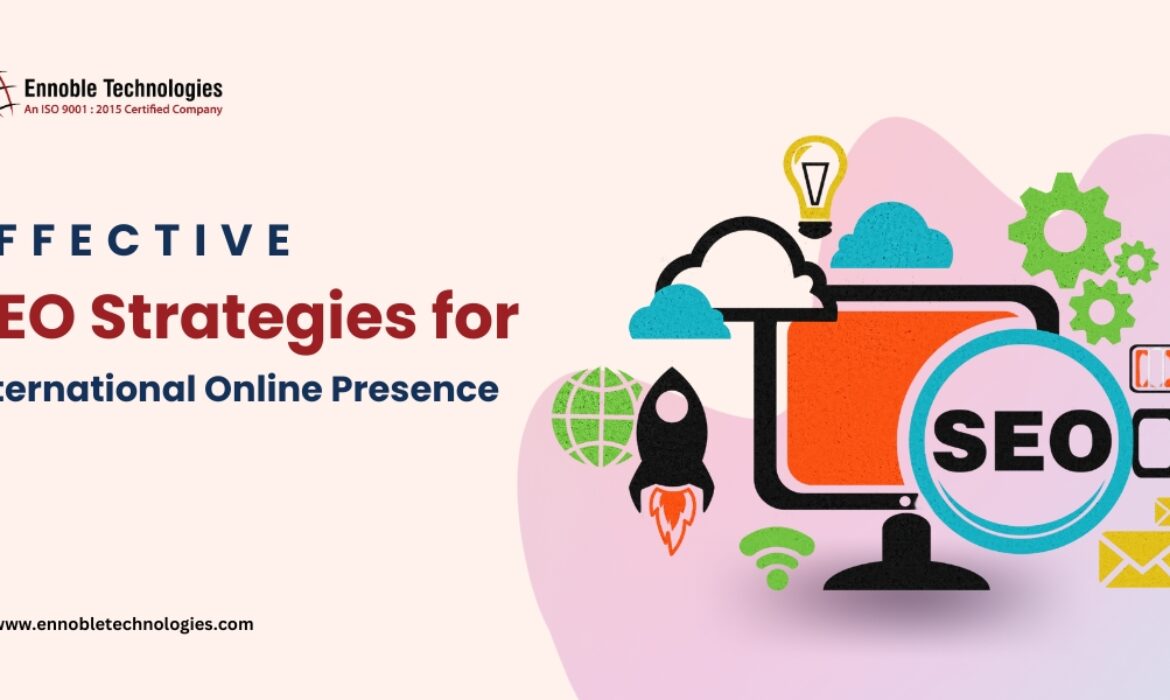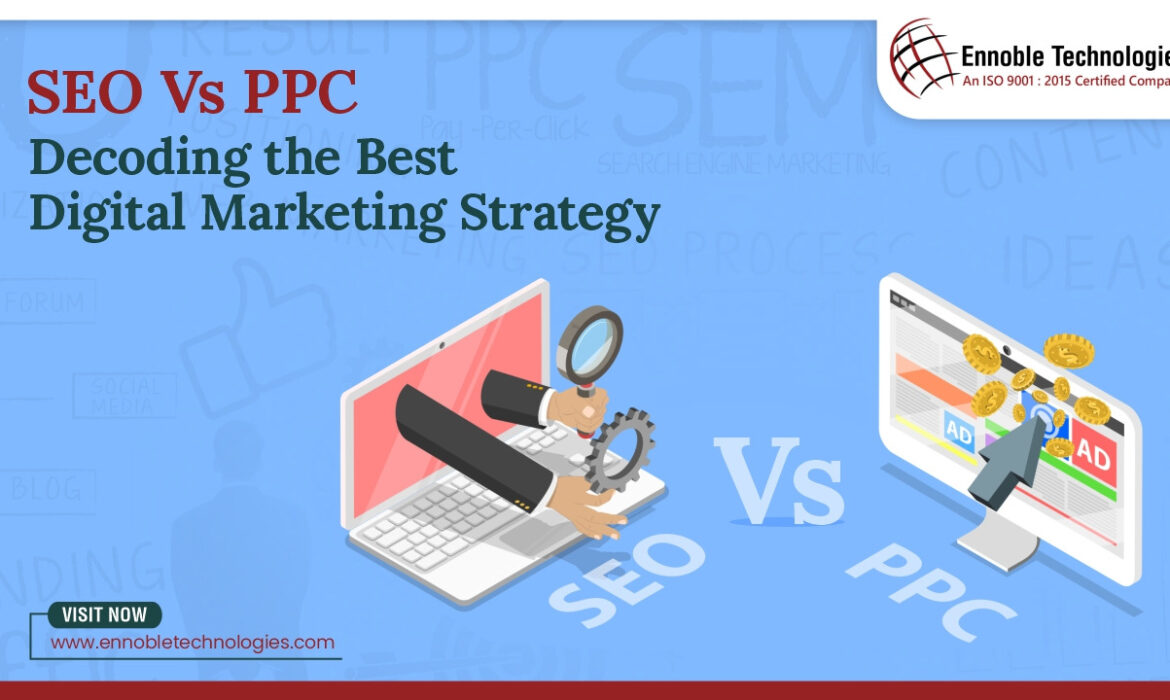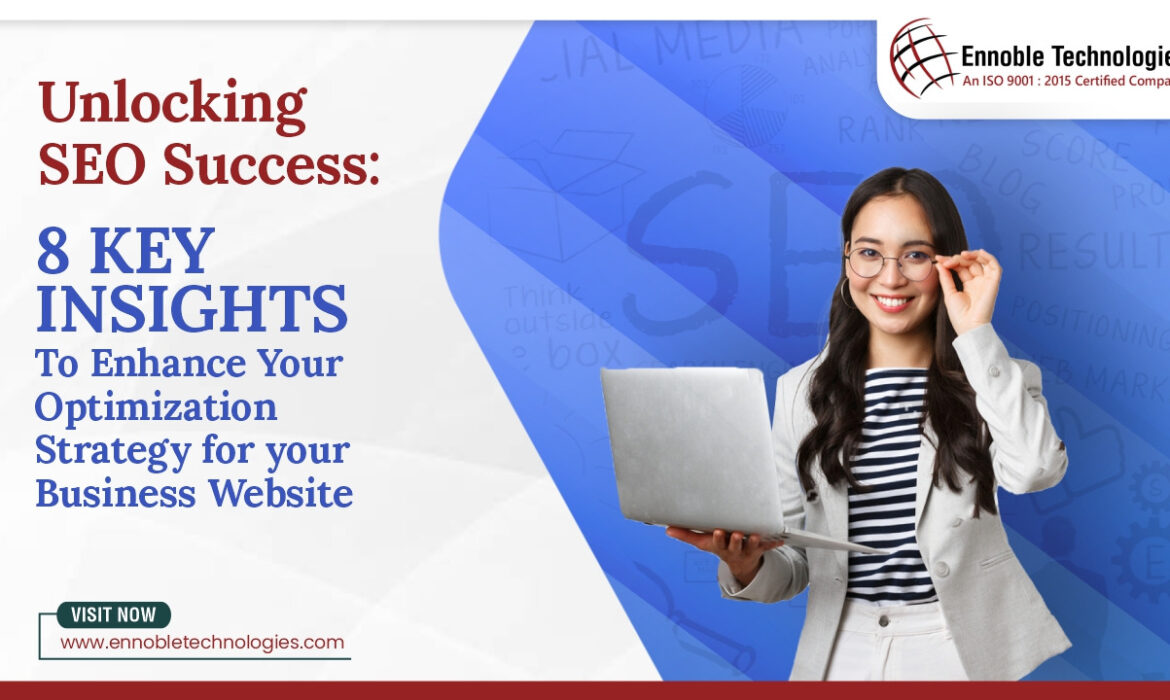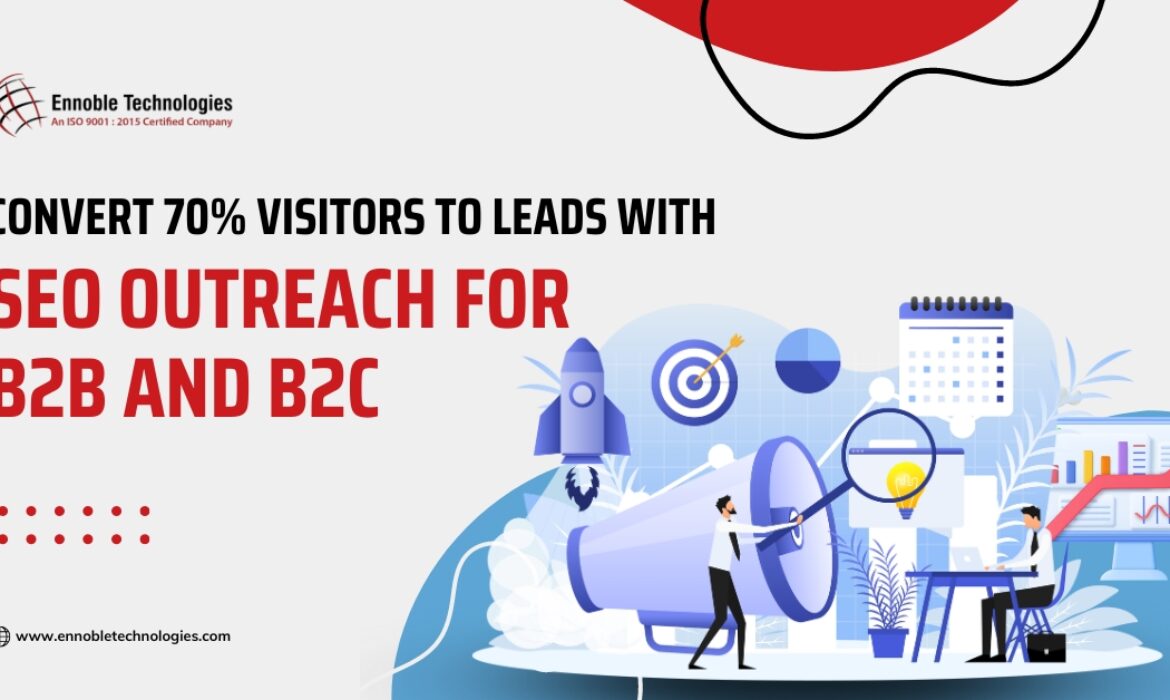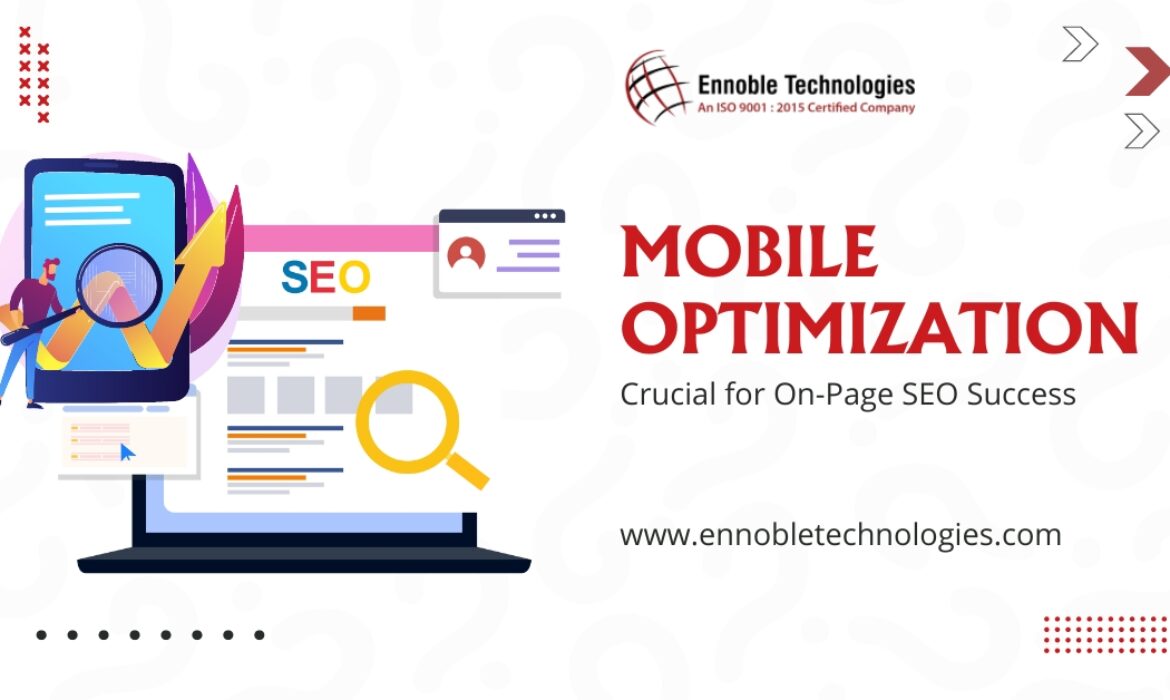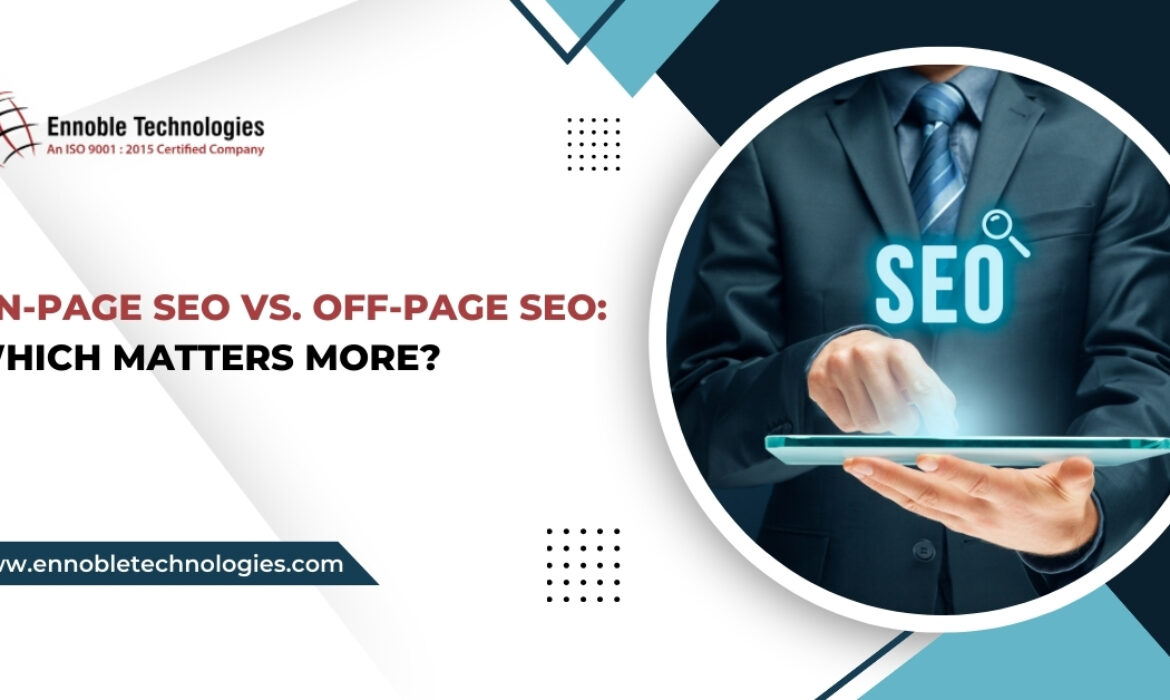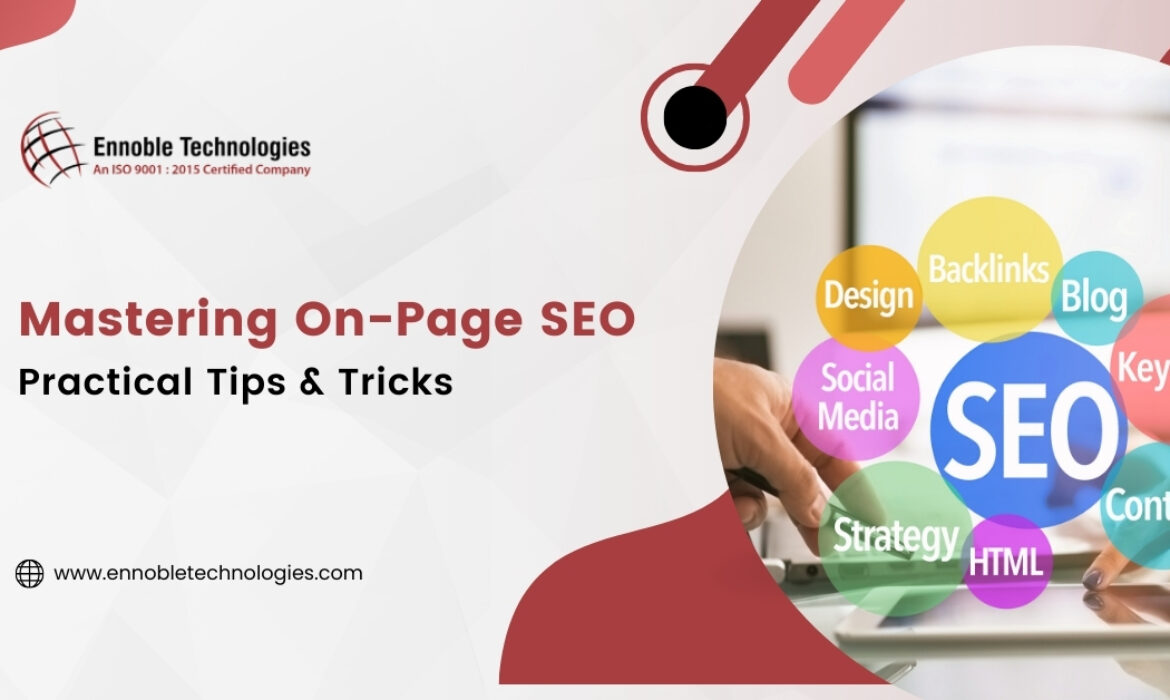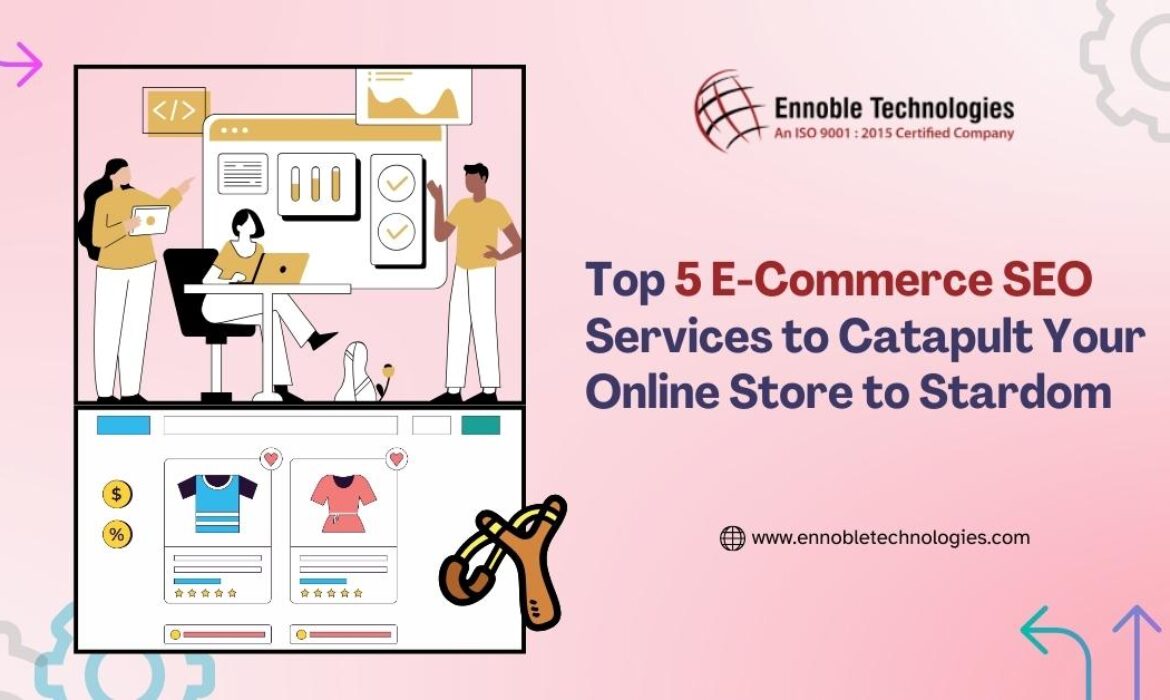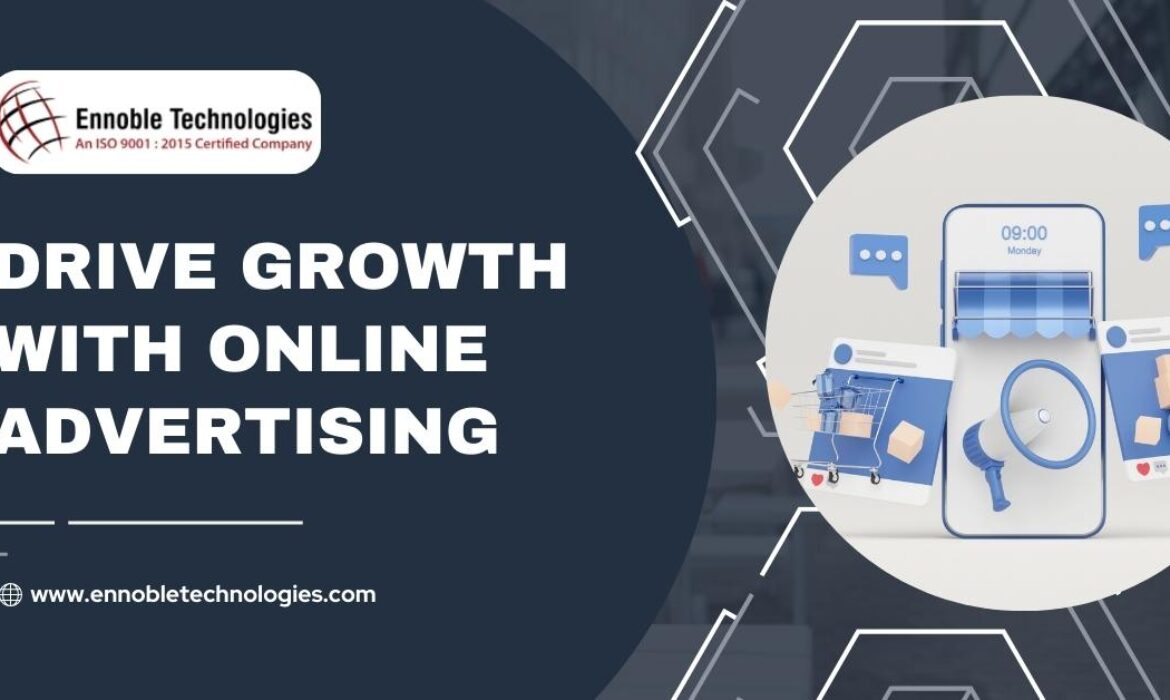Effective SEO Strategies for International Online Presence
In today’s interconnected world, businesses are no longer confined to their local markets. To thrive, companies must expand their reach to international audiences. Effective SEO strategies play a crucial role in achieving a robust online presence across different regions. At Ennoble Technologies, we specialize in providing top-notch global search engine optimization services that cater to diverse cultural and linguistic needs. In this blog, we’ll explore international SEO techniques and SEO best practices to help your business succeed on the global stage.
Understanding the Importance of International SEO
International SEO techniques are essential for businesses aiming to attract and engage customers worldwide. Unlike traditional SEO, which focuses on optimizing a website for a single country or language, global search engine optimization requires a more nuanced approach. This involves adapting your content, keywords, and overall strategy to meet the needs of different regions.
Multilingual SEO Strategies
One of the most important aspects of effective SEO strategies for international markets is the implementation of multilingual SEO strategies. This involves translating and localizing your website’s content to cater to various languages spoken by your target audience. At Ennoble Technologies, we understand the importance of providing accurate and culturally relevant translations to enhance user experience and improve search engine rankings.

Benefits of Multilingual SEO:
- Enhanced User Experience: Offering content in multiple languages makes it easier for users to understand and engage with your website.
- Increased Traffic: By catering to a broader audience, you can attract more visitors from different regions.
- Higher Conversion Rates: When users can access information in their native language, they are more likely to convert into customers.
SEO Best Practices for Different Regions
Implementing SEO best practices for different regions is crucial for the success of your international SEO efforts. Each region has its own unique search behaviors, preferences, and trends. At Ennoble Technologies, we tailor our effective SEO strategies to meet the specific needs of each market.
Key Considerations:
- Keyword Research: Conduct thorough keyword research to identify the most relevant terms for each region. This includes understanding local search intent and preferences.
- Content Localization: Adapt your content to reflect the cultural and linguistic nuances of each region. This goes beyond translation and involves customizing your messaging to resonate with local audiences.
- Technical SEO: Ensure that your website’s technical elements, such as hreflang tags, URL structures, and mobile optimization, are set up correctly for international SEO.
Leveraging SEO Analytics Tools

To measure the success of your effective SEO strategies, it’s essential to utilize SEO analytics tools. These tools provide valuable insights into your website’s performance, user behavior, and search engine rankings across different regions.
Essential SEO Analytics Tools:
- Google Analytics: Track website traffic, user demographics, and conversion rates.
- Google Search Console: Monitor your website’s presence in search results and identify any issues.
- Ahrefs: Analyze backlinks, keyword rankings, and competitor performance.
- SEMrush: Conduct comprehensive keyword research and track your SEO progress.
At Ennoble Technologies, we leverage these tools to provide our clients with data-driven insights and actionable recommendations. This enables us to continuously optimize our global search engine optimization efforts and achieve better results.
Cross-Border SEO Solutions
Expanding your online presence to international markets requires a strategic approach to cross-border SEO solutions. Ennoble Technologies offers a range of services designed to help businesses overcome the challenges of international SEO and achieve their goals.
Our Cross-Border SEO Solutions Include:
- Market Research: Conduct in-depth research to understand the target market’s needs, preferences, and competition.
- Content Strategy: Develop a content strategy that aligns with the cultural and linguistic requirements of each region.
- Link Building: Build high-quality backlinks from reputable websites in different regions to boost your website’s authority.
- Local SEO: Optimize your website for local search engines and directories to improve visibility in specific markets.
Regional SEO Strategies
Implementing regional SEO strategies is vital for businesses looking to establish a strong presence in specific geographic areas. Ennoble Technologies excels in creating customized effective SEO strategies that cater to the unique needs of different regions.
Key Elements of Regional SEO:
- Local Keywords: Identify and target keywords that are specific to the region you are targeting.
- Localized Content: Create content that addresses the interests and concerns of the local audience.
- Local Backlinks: Acquire backlinks from local websites and directories to improve your website’s authority in the region.
- Google My Business: Optimize your Google My Business profile to enhance local search visibility.
Multicultural SEO Services

Catering to a diverse audience requires a deep understanding of cultural differences and preferences. Ennoble Technologies offers multicultural SEO services that help businesses connect with customers from various cultural backgrounds.
Benefits of Multicultural SEO:
- Broader Reach: By appealing to a diverse audience, you can expand your customer base and increase your market share.
- Improved Engagement: Tailoring your content to different cultural preferences enhances user engagement and satisfaction.
- Higher ROI: Effective multicultural SEO can lead to higher conversion rates and better return on investment.
SEO Localization Expertise
SEO localization expertise is essential for businesses looking to optimize their websites for different languages and regions. At Ennoble Technologies, we have a team of experts who specialize in SEO localization to ensure that your content is culturally relevant and search engine-friendly.
Key Aspects of SEO Localization:
- Language Adaptation: Translate and adapt your content to meet the linguistic needs of your target audience.
- Cultural Relevance: Ensure that your content resonates with the cultural norms and preferences of each region.
- Technical Optimization: Implement technical SEO elements, such as hreflang tags and localized URLs, to improve search engine rankings.
Geo-Targeted SEO Solutions
For businesses targeting specific geographic areas, geo-targeted SEO solutions are crucial. Ennoble Technologies offers geo-targeted SEO solutions that help businesses improve their visibility in local search results and attract more customers from specific regions.
Key Components of Geo-Targeted SEO:
- Local Keywords: Identify and target keywords that are relevant to the specific geographic area.
- Local Content: Create content that addresses the needs and interests of the local audience.
- Local Listings: Optimize your website for local directories and listings to enhance local search visibility.
- Google Maps Optimization: Optimize your Google Maps listing to improve local search rankings.
Conclusion
In conclusion, implementing effective SEO strategies is essential for businesses looking to establish a strong international online presence. At Ennoble Technologies, we offer a comprehensive range of global search engine optimization services, including multilingual SEO strategies, cross-border SEO solutions, and geo-targeted SEO solutions. By leveraging our expertise and utilizing advanced SEO analytics tools, we help businesses achieve their international SEO goals and connect with customers worldwide. Whether you are looking to expand your reach to new markets or enhance your visibility in specific regions, Ennoble Technologies has the knowledge and experience to deliver results. Contact us today to learn more about our multicultural SEO services and how we can help your business succeed on the global stage.
Read more: Unlocking Google AdWords PPC Strategies for Success
PPC and SEO: Decoding the Best Digital Marketing Strategy
Introduction to PPC and SEO
PPC and SEO are two fundamental digital marketing strategies. PPC involves paying for ads to appear at the top of search engine results or on social media platforms, providing immediate visibility and targeted traffic. In contrast, SEO focuses on optimizing a website to rank higher in organic search results through high-quality content, technical improvements, and backlinks, ensuring sustainable and long-term traffic growth. Together, PPC and SEO complement each other by offering both instant results and a lasting online presence, making them essential for a comprehensive digital marketing approach.
What is PPC (Pay-Per-Click)?

PPC, or Pay-Per-Click, is a digital advertising model where advertisers pay a fee each time their ad is clicked. Essentially, it’s a way to buy visits to your site, driving targeted traffic quickly and efficiently.
How It Works:
- Advertising Platforms: The most popular PPC platforms are Google Ads, Bing Ads, Facebook Ads, and LinkedIn Ads. Each platform has its own unique set of features, audience targeting options, and ad formats.
- Keyword Bidding: Advertisers bid on specific keywords related to their products or services. When users search for these keywords, the ads may appear on the search engine results pages (SERPs) or within the chosen platform.
- Ad Placement: Depending on the platform, ads can appear in various formats and locations. For example, Google Ads can display text ads above organic search results, while Facebook Ads might show image or video ads within a user’s feed.
- Cost Structure: PPC operates on a bidding system where the cost per click (CPC) can vary greatly depending on keyword competitiveness, industry, and ad quality. Advertisers can set daily or monthly budgets to control their spending.
- Ad Types: There are several types of PPC ads, including search ads (text-based), display ads (banner images), shopping ads (product listings), and video ads. Each type serves different purposes and can be tailored to specific marketing goals.
PPC is particularly effective for businesses looking to achieve quick results and drive immediate traffic to their websites. It’s an excellent strategy for promotions, product launches, and gaining visibility in competitive markets.
What is SEO (Search Engine Optimization)?

SEO, or Search Engine Optimization, is the practice of enhancing your website to improve its visibility in organic search engine results. Unlike PPC, SEO focuses on earning traffic rather than paying for it, making it a cost-effective strategy in the long run.
How It Works:
- Keyword Research: The foundation of SEO is understanding what terms and phrases your potential customers use to find products or services similar to yours. Tools like Google Keyword Planner, SEMrush, and Ahrefs can help identify valuable keywords.
- On-Page SEO: This involves optimizing individual pages on your website. Key elements include integrating target keywords into your content, crafting compelling meta descriptions, using header tags (H1, H2, etc.), and ensuring images have descriptive alt text.
- Technical SEO: Ensuring your website is technically sound is crucial for SEO success. This includes optimizing site speed, ensuring mobile-friendliness, creating a clean URL structure, and submitting sitemaps for proper indexing by search engines.
- Content Creation: High-quality, relevant content is king in the world of SEO. Regularly publishing informative and engaging blog posts, articles, and other content types can attract and retain visitors, while also signaling to search engines that your site is active and valuable.
- Link Building: Acquiring backlinks from reputable websites helps to build your site’s authority. Techniques include guest blogging, creating shareable infographics, and developing relationships with industry influencers.
- User Experience (UX): SEO isn’t just about search engines; it’s also about providing a great experience for your users. A well-designed, easy-to-navigate site can reduce bounce rates and increase the time visitors spend on your site, both of which are positive signals to search engines.
SEO is a long-term strategy that requires patience and continuous effort. However, the payoff can be substantial, with a steady stream of free, organic traffic to your site and a stronger online presence.
Summary and Transition to Comparison
Now that we’ve detailed the fundamentals of both PPC and SEO, let’s transition into comparing these two powerful digital marketing strategies. Each has its own strengths and is suited to different goals and situations. Whether you’re looking for quick, measurable results or aiming to build a robust, long-term presence, understanding the nuances of PPC and SEO will help you make informed decisions for your marketing efforts.
Shall we dive into a detailed comparison of their benefits, drawbacks, and best-use scenarios?
Detailed Comparison of PPC and SEO

Now that we have a thorough understanding of what PPC (Pay-Per-Click) and SEO (Search Engine Optimization) entail, let’s dive into a detailed comparison to help you determine which strategy might be best for your needs.
Speed of Results
PPC: Immediate Impact
- PPC campaigns can be set up quickly, and ads can start driving traffic almost immediately after launch.
- Ideal for businesses needing rapid results, such as during a product launch or a time-sensitive promotion.
SEO: Long-Term Growth
- SEO takes time to show results, often several months of consistent effort.
- Suitable for businesses aiming for sustained, long-term growth and building a robust online presence.
Cost Considerations
PPC: Controlled but Ongoing Costs
- PPC requires an ongoing investment. You pay each time someone clicks on your ad, with costs varying based on keyword competitiveness and bid amounts.
- Allows precise budget control, but costs can add up, especially in competitive industries.
SEO: Upfront Effort, Lower Long-Term Costs
- SEO involves significant upfront effort in optimizing the site and creating content. However, once your site starts ranking well, the traffic is essentially free.
- Long-term investment with potentially high ROI, but requires patience and continuous optimization.
Traffic Sustainability
PPC: Temporary Boost
- PPC provides a temporary boost in traffic. Once you stop paying for ads, the traffic stops.
- Best for short-term campaigns or when immediate visibility is crucial.
SEO: Sustainable and Evergreen
- SEO efforts lead to sustainable traffic growth. High-ranking content can continue to attract visitors for months or even years without additional costs.
- Great for building long-term authority and consistent traffic flow.
Trust and Credibility
PPC: Perceived as Ads
- PPC ads are often clearly marked as advertisements, which some users may distrust or ignore.
- Effective for visibility but may not always build long-term trust.
SEO: Earned Credibility
- SEO results are seen as more credible and trustworthy by users since they are earned through relevance and quality.
- Enhances your brand’s authority and trustworthiness over time.
Targeting and Customization
PPC: Precise Targeting
- PPC allows detailed targeting options, including demographics, geographic locations, time of day, and even user behaviors.
- Perfect for highly targeted campaigns aiming to reach specific audiences.
SEO: Broad Targeting
- SEO targets users based on search intent and relevant content. It’s less precise than PPC but can attract a wider audience looking for information.
- Effective for capturing broad interest and various stages of the buyer’s journey.
Measurement and Analytics
PPC: Detailed Metrics
- PPC provides extensive analytics, including click-through rates (CTR), conversion rates, cost per click (CPC), and return on ad spend (ROAS).
- Facilitates precise measurement and adjustment of campaigns for optimal performance.
SEO: Complex Metrics
- SEO analytics include organic traffic, keyword rankings, bounce rates, and time on site. Tools like Google Analytics and Search Console provide insights.
- Measuring SEO performance is more complex and involves tracking multiple metrics over time.
Adaptability and Flexibility
PPC: Quick Adjustments
- PPC campaigns can be quickly adjusted in response to performance data or market changes.
- Highly flexible, allowing for rapid testing of different ads and strategies.
SEO: Slow Adaptation
- SEO changes, such as updating content or building new links, take time to reflect in search rankings.
- Requires a more strategic and patient approach to adapt to changes in search algorithms and user behavior.
Use Case Scenarios
When to Use PPC:
- Launching a new product or service and needing immediate visibility.
- Running time-sensitive promotions or sales.
- Targeting specific demographics with precise ads.
- Testing market response quickly.
When to Use SEO:
- Building a long-term, sustainable online presence.
- Enhancing brand credibility and authority.
- Targeting a broad audience at various stages of the buying cycle.
- Investing in a cost-effective strategy with high ROI over time.
PPC (Pay-Per-Click)
Advantages:
Immediate Results: PPC can generate traffic as soon as your ads go live.
Targeted Advertising: You can target specific demographics, locations, and even times of the day.
Control Over Budget: You can set a specific budget and only pay when someone clicks on your ad.
Measurable Results: PPC platforms provide detailed analytics on ad performance.
Brand Visibility: PPC ads appear at the top of search results, enhancing brand visibility.
Disadvantages:
Cost: Can be expensive, especially for competitive keywords.
Temporary: Traffic stops when you stop paying for ads.
Ad Blindness: Some users ignore ads, focusing instead on organic search results.
Continuous Management: Requires ongoing management and optimization to remain effective.
SEO (Search Engine Optimization)
Advantages:
Cost-Effective: Organic traffic is free once your site ranks well.
Sustainable Results: SEO efforts can lead to long-term traffic growth.
Credibility and Trust: Organic search results are often perceived as more trustworthy.
Increased Click-Through Rates (CTR): Higher CTR compared to PPC ads.
Improves User Experience: SEO focuses on creating high-quality content and a better user experience.
Disadvantages:
Time-Consuming: Takes time to see results, often several months.
Algorithm Changes: Search engines frequently update their algorithms, which can affect rankings.
Complexity: SEO requires a deep understanding of search engine algorithms and ranking factors.
Ongoing Effort: Continuous effort and updates are needed to maintain and improve rankings.
Key Differences
- Speed: PPC provides immediate results, while SEO is a long-term strategy.
- Cost: PPC requires ongoing investment, while SEO involves upfront effort but can yield long-term free traffic.
- Sustainability: SEO provides sustainable traffic, while PPC requires constant spending.
- Trust and Credibility: SEO tends to build more trust with users compared to PPC.
- Targeting: PPC allows precise targeting options, whereas SEO targets are based on keyword optimization and content relevance.
Let’s delve deeper into how to integrate PPC and SEO effectively to maximize your digital marketing efforts.
Integrating PPC and SEO
Combining PPC and SEO strategies can create a powerful synergy, enhancing your overall online presence and driving more significant results. Here’s how you can effectively integrate both approaches:

1. Keyword Strategy
Unified Keyword Research:
- Conduct comprehensive keyword research to identify high-performing keywords for both PPC and SEO.
- Use tools like Google Keyword Planner, Ahrefs, and SEMrush to find keywords that have high search volumes and relevance to your business.
- Identify overlapping keywords that can be targeted in both PPC campaigns and SEO content.
Complementary Keywords:
- Use PPC data to discover high-converting keywords that might not yet rank well organically.
- Optimize your SEO content for these high-performing PPC keywords to gradually improve organic rankings.
- Utilize long-tail keywords in SEO that may be too expensive to target with PPC.
2. Content Marketing
Content Creation:
- Develop high-quality, engaging content based on your keyword research. This content can serve both SEO and PPC purposes.
- Create blog posts, articles, videos, and infographics that address the needs and interests of your target audience.
- Use PPC to promote your content and drive immediate traffic, while simultaneously working on organic rankings.
Landing Pages:
- Design landing pages optimized for both PPC conversions and SEO. Ensure they are relevant to the ad copy and keywords used in your PPC campaigns.
- A/B test different landing pages to determine which performs best in terms of conversions and user engagement.
- Optimize these pages for SEO by incorporating target keywords, meta descriptions, and quality content.
3. Data Sharing and Insights
Performance Analytics:
- Share data between your PPC and SEO teams to gain comprehensive insights into which strategies are working best.
- Use PPC data to identify which keywords and ad copies generate the most conversions, then apply these insights to your SEO strategy.
- Analyze SEO performance to understand which keywords and content pieces drive the most organic traffic, and consider incorporating these into your PPC campaigns.
Conversion Tracking:
- Implement conversion tracking for both PPC and SEO efforts to measure the effectiveness of each strategy.
- Use tools like Google Analytics, Google Ads, and other marketing platforms to track user behavior, conversions, and ROI.
- Compare conversion data to understand the customer journey and how PPC and SEO contribute to different stages of the funnel.
4. Brand Visibility and Credibility
Enhanced Brand Presence:
- Use PPC to gain immediate visibility at the top of search engine results while your SEO efforts build up.
- Having both paid ads and organic listings appear on the same SERP can increase brand credibility and capture more real estate.
- This dual presence can improve click-through rates (CTR) and provide a more robust online presence.
Reinforcing Messaging:
- Ensure your PPC ads and SEO content deliver consistent messaging and branding.
- Use similar headlines, value propositions, and calls-to-action (CTAs) across both channels to reinforce your brand message.
- This consistency helps build trust and recognition among your audience.
5. Local Search Optimization
Local SEO and PPC:
- For businesses targeting local customers, integrate local SEO practices with PPC campaigns.
- Optimize your Google My Business listing and use local keywords in your SEO content.
- Run location-based PPC ads to attract local traffic and increase visibility in your target areas.
Practical Steps to Integrate PPC and SEO
- Regular Meetings and Collaboration:
- Schedule regular meetings between your PPC and SEO teams to discuss strategies, share insights, and align goals.
- Foster a collaborative environment where both teams work together to enhance overall performance.
- Unified Reporting:
- Create unified reports that include metrics from both PPC and SEO campaigns. This helps in understanding the bigger picture and making informed decisions.
- Use these reports to identify opportunities for improvement and areas where integration can be enhanced.
- Consistent Optimization:
- Continuously optimize both PPC and SEO efforts based on performance data. Adjust bids, ad copies, and keywords for PPC, and update content, meta tags, and technical aspects for SEO.
- Stay updated with algorithm changes and industry trends to keep both strategies effective and relevant.
On a final note:
By integrating PPC and SEO, you can leverage the strengths of both strategies to achieve comprehensive digital marketing success. This approach not only maximizes your reach and visibility but also ensures that you capture and convert traffic at every stage of the customer journey. Regular collaboration, data sharing, and consistent optimization are key to creating a harmonious and effective marketing strategy.
Read more : https://ennoblegrp.com/social-media/power-of-youtube-marketing/
Unlocking SEO Success: 8 Key Insights to Enhance Your Optimization Strategy for Your Business Website
1. Optimize for Featured Snippets
Understanding Featured Snippets: A Primer for SEO Success
To achieve SEO success, it’s crucial to understand the significance of featured snippets in search engine results. Featured snippets occupy the top position in search results and mastering them can significantly enhance your website’s visibility and organic traffic. By focusing on providing concise, direct answers to common questions related to your business or industry, you can optimize your content for the coveted featured snippet spot, ultimately contributing to your SEO success.
Cracking the Code: Strategies to Optimize for Featured Snippets
In the quest for SEO success, it’s essential to crack the code of featured snippets by identifying high-opportunity keywords and structuring your content to provide relevant and comprehensive answers. Crafting content that aligns with the types of featured snippets, such as paragraphs, lists, or tables, can increase the likelihood of your content being selected for the coveted position. Employing schema markup and optimizing for voice search are additional strategies to enhance your SEO success in featured snippet optimization.
Targeting Position Zero: Tips for Featured Snippet Optimization
Targeting position zero, the coveted spot for featured snippets, requires a proactive approach to content optimization. By conducting thorough keyword research and analyzing existing featured snippets for your target keywords, you can identify opportunities to create content that stands out. Crafting compelling, informative content that directly addresses user queries can position your website as a valuable resource and increase the likelihood of earning featured snippet placements, ultimately contributing to your SEO success.
2. Implement Advanced Schema Markup

Harnessing Advanced Schema Markup for Enhanced SEO
In the pursuit of SEO success, harnessing advanced schema markup is paramount. Advanced schema markup allows websites to provide search engines with detailed information about their content, resulting in enhanced visibility and higher click-through rates. By implementing advanced schema markup strategies, websites can improve their chances of appearing in rich results and featured snippets, ultimately contributing to their SEO success.
Unleashing the Power of Schema Markup: Advanced Strategies
Unleashing the power of schema markup involves advanced strategies that go beyond the basics. By incorporating advanced schema markup techniques such as product markup, FAQ schema, and how-to schema, websites can provide search engines with valuable context about their content, leading to improved visibility and higher search engine rankings. Implementing these advanced strategies is essential for achieving SEO success in today’s competitive digital landscape.
Elevating Your SEO Game with Advanced Schema Implementation
Elevating your SEO game requires advanced schema implementation to stand out in search engine results. By utilizing advanced schema markup, websites can enhance their search listings with rich snippets, knowledge panels, and other rich results, ultimately leading to increased organic traffic and improved SEO success. Advanced schema implementation is a game-changer for websites looking to maximize their visibility and impact in search results.
Beyond Basics: Advanced Techniques for Schema Markup Optimization
To achieve SEO success, it’s crucial to go beyond the basics and leverage advanced techniques for schema markup optimization. Advanced schema markup optimization involves detailed structuring of data to provide search engines with comprehensive information about web content, ultimately leading to improved relevance and visibility in search results. Embracing these advanced techniques is essential for websites aiming to achieve SEO success through schema markup optimization.
3. Enhancing Core Web Vitals for Seamless User Experience
Core Web Vitals Demystified: Enhancing User Experience for SEO
In the world of SEO, understanding and optimizing Core Web Vitals is crucial for achieving SEO success. These key metrics, including loading performance, interactivity, and visual stability, directly impact user experience and search engine rankings. By prioritizing Core Web Vitals, website owners can enhance the overall user experience, leading to improved SEO performance.
Mastering Core Web Vitals: Techniques for SEO Success
To achieve SEO success, mastering Core Web Vitals is essential. Techniques such as optimizing server response times, minimizing render-blocking resources, and leveraging browser caching can significantly improve these vital metrics. By focusing on Core Web Vitals, website owners can ensure that their sites provide a seamless and engaging user experience, ultimately leading to better search engine visibility.
Speed Matters: Optimizing Loading Times for Better Web Vitals
One of the most critical aspects of Core Web Vitals is loading performance. Optimizing loading times through techniques such as image optimization, code minification, and content delivery network (CDN) implementation can greatly enhance Web Vitals and contribute to SEO success. By prioritizing speed and performance, website owners can create a more favorable environment for both users and search engines.
The Importance of Core Web Vitals in SEO: Best Practices
When it comes to SEO success, understanding the importance of Core Web Vitals is paramount. Implementing best practices such as reducing first input delay, optimizing cumulative layout shift, and prioritizing largest contentful paint can significantly improve overall Web Vitals. By focusing on these best practices, website owners can ensure that their sites meet the necessary criteria for optimal user experience and search engine performance.
4. Understanding the Power of Topic Clusters and Pillar Pages

Unleashing SEO Potential: Harnessing Topic Clusters and Pillar Pages
Unlock the true potential of SEO success by harnessing the power of topic clusters and pillar pages. By organizing your content around these strategic structures, you can enhance your website’s visibility and authority in search engine results.
Strategic Content Architecture: Leveraging Topic Clusters for SEO Success
Crafting a strategic content architecture that leverages topic clusters is essential for achieving SEO success. By organizing related content into clusters and linking them to a pillar page, you can signal to search engines the relevance and depth of your expertise, driving improved rankings and visibility.
Building Authority: How Pillar Pages Drive SEO Performance
Pillar pages play a pivotal role in building authority and driving SEO performance. By serving as comprehensive guides to broad topics and linking to related cluster content, pillar pages demonstrate your website’s expertise and relevance, leading to enhanced search engine rankings and visibility.
Connecting the Dots: Creating Topic Clusters for Improved SEO
Creating topic clusters is crucial for connecting the dots and improving SEO performance. By grouping related content around a central theme and interlinking them strategically, you can signal to search engines the depth and breadth of your content, resulting in improved visibility and rankings.
Topic Clusters Unveiled: A Comprehensive Guide to SEO Strategy
Unveil the power of topic clusters as a comprehensive SEO strategy. By organizing your content into clusters and establishing clear topic authority, you can enhance your website’s relevance and visibility in search engine results, driving SEO success.
5. Optimizing for Voice Search: Embracing Future Trends for Enhanced SEO Performance
Voice Search Optimization: Paving the Way for Future SEO Success
In the ever-evolving landscape of SEO, voice search optimization has emerged as a pivotal factor for future success. As voice search continues to gain prominence, adapting your SEO strategy to accommodate this trend is crucial for staying ahead of the competition. By focusing on voice search optimization, you can pave the way for sustained SEO success in the rapidly changing digital environment.
The Rise of Voice Search: Strategies to Stay Ahead in SEO
With the rise of voice search, it’s imperative to implement strategies that keep your SEO efforts ahead of the curve. Understanding the shift towards voice-based queries and tailoring your content to align with conversational search patterns are essential steps in ensuring continued SEO success. By acknowledging the rise of voice search and proactively optimizing your content, you can position your website for sustained visibility and success in search engine rankings.
Unlocking Voice Search Potential: Tips for SEO Optimization
Unlocking the potential of voice search requires strategic SEO optimization geared towards accommodating natural language queries. By incorporating long-tail keywords and structuring your content to provide direct, concise answers, you can enhance your website’s visibility and authority in voice search results. Optimizing for voice search presents a valuable opportunity to fortify your SEO success and connect with a broader audience through conversational interactions.
Voice Search SEO: Adapting Your Strategy for Changing Trends
Adapting your SEO strategy to encompass voice search is essential for maintaining relevance amidst changing search trends. Embracing voice search SEO involves aligning your content with the nuances of spoken queries and focusing on contextually relevant responses. By acknowledging and adapting to changing search trends, you can position your website for sustained SEO success in the era of voice-driven interactions.
6. Achieving SEO Success through Video Optimization: Engage, Educate, and Elevate

Lights, Camera, Action: The Role of Video Optimization in SEO Success
In the competitive landscape of online visibility, video optimization plays a pivotal role in achieving SEO success. Incorporating video content into your SEO strategy can significantly enhance your website’s visibility and authority, ultimately leading to increased traffic and higher rankings on search engine result pages.
Unlocking Potential: Strategies for Effective Video SEO
To unlock the full potential of video content for SEO success, it is crucial to implement strategic video SEO techniques. By optimizing video titles, descriptions, and tags with relevant keywords, you can improve your content’s discoverability and relevance, thus driving SEO success through enhanced visibility and engagement.
From Content to Conversion: Maximizing ROI with Video Optimization
Maximizing ROI through video optimization involves not only creating compelling and relevant video content, but also ensuring that it is effectively optimized for search engines. By aligning video content with user intent and leveraging call-to-action overlays and annotations, you can drive conversions and achieve SEO success through increased user engagement and action.
7. Enhance E-A-T for Credible and Authoritative Websites
Understanding E-A-T: Building Blocks of Credibility in SEO
In the realm of SEO success, understanding E-A-T (Expertise, Authoritativeness, Trustworthiness) is fundamental. E-A-T serves as the cornerstone for building credibility and trust with both users and search engines. By comprehending and implementing E-A-T principles, websites can lay a solid foundation for achieving SEO success.
Elevating Authority: Strategies to Enhance E-A-T for SEO
Elevating authority through strategic implementation of E-A-T principles is paramount for SEO success. By showcasing expertise, establishing authoritativeness, and building trustworthiness, websites can enhance their E-A-T signals, thereby boosting their credibility and visibility in search engine results. Elevating authority through E-A-T strategies is a crucial step towards long-term SEO success.
Trust Matters: Optimizing E-A-T for Website Credibility
In the context of SEO success, trust matters significantly, and optimizing E-A-T is essential for establishing website credibility. By focusing on transparency, user-centric content, and authoritative backlinks, websites can strengthen their E-A-T factors, ultimately enhancing their trustworthiness and credibility in the eyes of search engines and users.
The Role of Expertise: Establishing Authority in Your Niche
Establishing expertise plays a pivotal role in achieving authority within your niche for SEO success. By demonstrating in-depth knowledge, industry leadership, and valuable insights, websites can position themselves as authoritative sources, thereby strengthening their E-A-T signals and paving the way for SEO success.
Authoritativeness in Action: Techniques to Boost E-A-T Signals
Taking action to boost authoritativeness through effective E-A-T techniques is crucial for SEO success. By delivering high-quality, well-researched content, showcasing industry accolades, and earning endorsements from reputable sources, websites can actively enhance their authoritativeness, thereby solidifying their position in search engine rankings.
8. Unlock SEO Success with AI and Machine Learning Tools: Enhancing Your Strategy

AI and Machine Learning in SEO: A Game-Changer for SEO Success
In the ever-evolving landscape of SEO, AI and machine learning are proving to be a game-changer for achieving SEO success. By leveraging advanced algorithms and data-driven insights, AI technologies empower businesses to make informed decisions and stay ahead of the competition. Embracing AI and machine learning in SEO strategies is crucial for staying competitive and achieving long-term SEO success.
Leveraging AI: Transforming Your SEO Strategy for SEO Success
Leveraging AI in your SEO strategy can significantly impact your SEO success. AI-powered tools can analyze large sets of data, identify patterns, and make real-time adjustments to optimize your website’s performance. By harnessing the power of AI, businesses can enhance their SEO strategies and drive sustainable SEO success in a dynamic digital landscape.
The Power of Data: Enhancing Insights with AI and Machine Learning for SEO Success
Harnessing the power of data through AI and machine learning can provide invaluable insights for achieving SEO success. By utilizing sophisticated algorithms to interpret data trends and user behavior, businesses can gain a deeper understanding of their target audience and tailor their SEO strategies accordingly. The integration of AI and machine learning in SEO empowers businesses to make data-driven decisions, ultimately leading to improved SEO success.
Read more: https://ennoblegrp.com/seo/seo-outreach-for-b2b-and-b2c/
Convert 70% visitors to leads with SEO Outreach for B2B and B2C
Introduction:
Imagine turning 70% of website visitors into engaged leads, simply by implementing the right SEO outreach strategies. Sounds impossible? It’s not – and we’ll show you how in this blog. In the dynamic realm of digital marketing, search engine optimization (SEO) outreach plays a pivotal role in both Business-to-Business (B2B) and Business-to-Consumer (B2C) sectors. This comprehensive guide explores the distinctive roles and significance of SEO outreach in driving visibility, credibility, and engagement for businesses targeting diverse audiences and markets.
—————————————————————————————————————————————————————–
What is B2B SEO?
B2B SEO involves optimizing your website and online presence to attract qualified business leads through organic search, leveraging targeted content and strategic outreach to cater to longer sales cycles and complex decision-making processes.
—————————————————————————————————————————————————————–
SEO Outreach in B2B Digital Marketing
In the competitive landscape of B2B digital marketing, SEO outreach stands out as a critical component for driving organic visibility, establishing authority, and generating high-quality leads. By implementing targeted outreach b2b strategies, building meaningful relationships, and continuously optimizing their approach, B2B marketers can unlock new opportunities for growth, differentiation, and success in their respective industries.
B2B Blogger Outreach Strategies: Building Authority and Relationships
Beyond standard Search engine optimization tactics, B2B outreach thrives on building genuine connections with bloggers and industry influencers. Here are key strategies to leverage:
1. Guest Blogging:
- Target relevant publications: Identify industry blogs, thought leader platforms, and online communities frequented by your target audience.
- Pitch valuable content: Offer unique insights, data-driven reports, or industry analyses relevant to their readers.
- Personalize your outreach: Don’t use generic templates. Research the editor’s interests and tailor your pitch to their specific audience.
- Build relationships: Don’t just see it as a one-time opportunity. Interact with their content, offer additional insights, and build long-term connections.
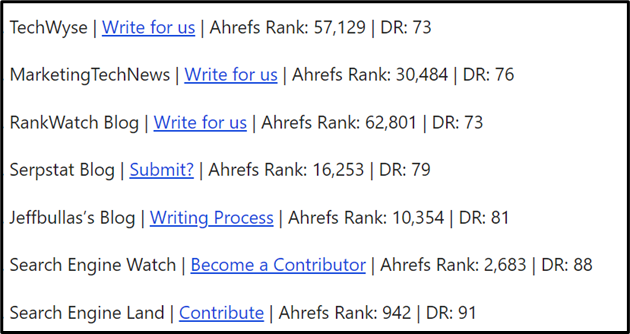
2. Influencer Marketing:
- Identify key influencers: Partner with industry experts, thought leaders, or niche bloggers who resonate with your target audience.
- Collaborate on valuable content: Co-create white papers, webinars, or podcasts addressing industry challenges and showcasing your expertise.
- Leverage their reach: Utilize their established audience to amplify your message and build brand awareness.
- Nurture authentic partnerships: Treat them as valued partners, not just marketing tools. Offer mutual benefits and respect their influence.
3. Create Shareable Content:
- Industry insights with a twist: Go beyond dry reports. Infographics, data visualizations, or interactive tools make complex information engaging.
- Problem-solving content: Address common pain points your target audience faces and offer practical solutions through blog posts, case studies, or guides.
- Leverage social media: Optimize content for different platforms and encourage sharing with relevant hashtags and calls to action.
- Run targeted contests: Partner with relevant bloggers to incentivize content creation and social sharing around your brand or industry topic.
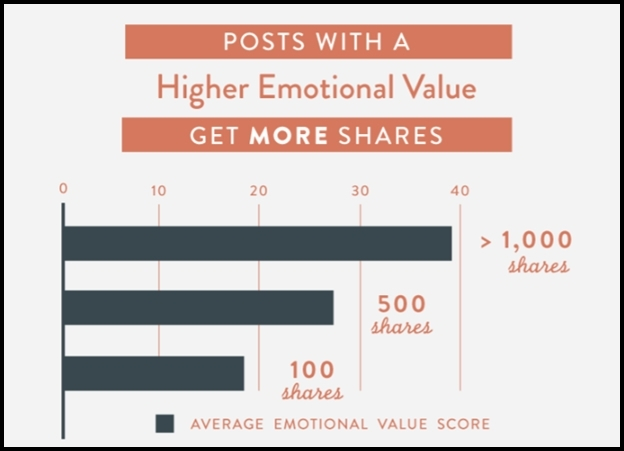
Source: buffer.com
—————————————————————————————————————————————————————–
How to Craft an SEO outreach strategy for B2B success:
Build relationships, leverage data, and create targeted content that resonates with decision-makers.
—————————————————————————————————————————————————————–
SEO Outreach in B2C Digital Marketing
Conversely, in the B2C realm, Search engine optimization outreach serves as a catalyst for engaging with individual consumers, driving brand awareness, and facilitating seamless interactions across diverse consumer segments. Key considerations and B2C SEO strategies for effective search engine optimization outreach in B2C digital marketing include Consumer-Centric Keyword Optimization, User-Centric Content Creation, E-commerce and Local Search engine optimization, Social Media Integration and Influencer Collaboration.

B2C Blogger Outreach Strategies: Engaging Communities and Sparking Conversation
B2C outreach thrives on emotional connection and captivating content. Here are key strategies to spark engagement and build brand love:
1. Interactive Experiences:
- Run contests and giveaways: Partner with relevant bloggers to host product giveaways, photo contests, or user-generated content challenges. This incentivizes interaction and brand awareness.
- Livestream events: Partner with micro-influencers for Q&A sessions, product demonstrations, or behind-the-scenes glimpses. Build a sense of community and excitement.
- Interactive quizzes and polls: Engage audiences with fun quizzes about your products or industry trends. Offer personalized discounts or recommendations based on results.

2. User-Generated Content (UGC):
- Encourage user-generated content: Partner with micro-influencers to create authentic product reviews, tutorials, or lifestyle content featuring your brand.
- Host hashtag campaigns: Encourage user-generated content with branded hashtags and incentives. Showcase the best submissions on your website and social media.
- Run UGC contests: Encourage photo or video submissions showcasing their experience with your brand. Reward creativity and offer exciting prizes.
3. Leverage Social Media Communities:
- Join relevant communities: Engage in discussions, answer questions, and offer valuable insights within relevant online communities and forums. Build trust and brand recognition.
- Partner with community leaders: Collaborate with community moderators or influential members to host AMAs, product demos, or exclusive events. Reach a targeted audience within a trusted space.
- Run community-specific promotions: Offer exclusive discounts or contests targeted towards specific online communities to incentivize engagement and brand loyalty.
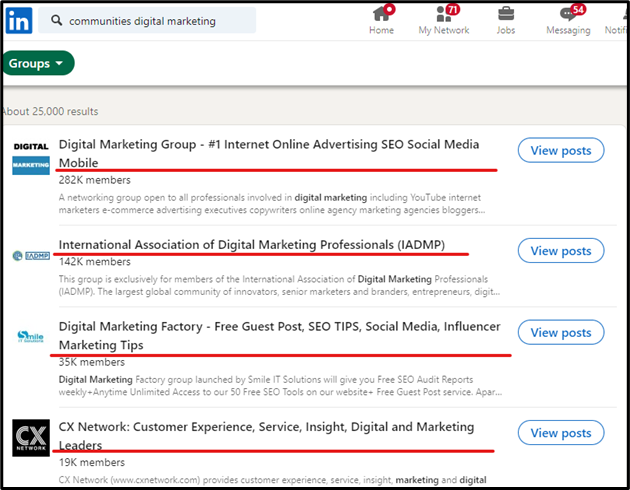
—————————————————————————————————————————————————————–
What is B2C SEO?
B2C SEO optimizes your online presence to attract individual consumers through search engines. Think engaging content, strategic keywords, and mobile-friendliness – all crafted to drive website visits and convert them into customers.
—————————————————————————————————————————————————————–
Common Principles and Best Practices
While the nuances of SEO outreach in B2B and B2C digital marketing are distinct, several common principles and best practices underpin the effectiveness of SEO outreach in both domains, including Content Quality and Relevance, User Experience and Mobile Optimization, Performance Monitoring and Data-Driven Optimization, Adaptation to Search Engine Algorithms and Trends.
Mastering the Double Play: B2B vs. B2C SEO Outreach in 2024
While both aim to build authority and attract leads, B2B and B2C SEO outreach strategies differ due to their unique target audiences and buying journeys. Here’s a quick breakdown:
| Feature | B2B | B2C |
| Target Audience | Decision-makers, businesses | Individual consumers |
| Sales Cycle | Longer, more complex | Shorter, impulse-driven |
| Focus | Building relationships, industry expertise | Brand awareness, emotional connection |
| Platforms | Industry publications, professional networks | Social media, influencer marketing |
| Content | White papers, case studies | Engaging visuals, interactive formats |
| Metrics | Domain authority, backlinks | Brand mentions, social engagement |
Current Trends in SEO Outreach:
Navigating the Ever-Evolving Landscape of SEO Outreach: Expert Insights from 10 Years in the Trenches
Gone are the days of generic, spray-and-pray outreach emails. Today’s SEO landscape demands a sophisticated, data-driven, and personalized approach that builds genuine relationships and resonates with your target audience. Here’s what I’ve learned in my 10-year journey, exploring the key trends shaping the future of SEO outreach:
1. Personalization is King (and Queen):
Forget mass blasting – it’s time to craft messages tailored to individual influencers and their audiences. Consider:
- Researching: Dive deep into their content, interests, and values to find common ground.
- Segmenting: Group influencers by niche, demographics, and engagement levels for targeted pitches.
- Hyper-personalizing: Use dynamic variables to address them by name and reference specific content they’ve created.
The ROI: A study by Yesware found that personalized emails have a 14% higher open rate and a 6% higher reply rate than generic ones.
Real-world example: Buzzsumo, a content marketing platform, saw a 300% increase in outreach success by personalizing pitches with relevant data about influencers’ past shares.
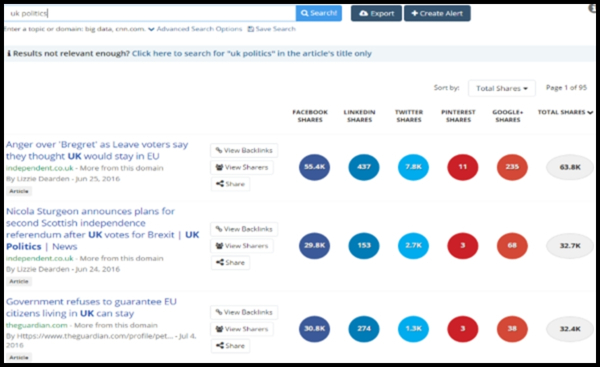
2. Data Drives Decisions:
Don’t gamble on gut feeling, leverage data to identify high-potential targets and track campaign performance. Tools like:
- Buzzsumo: Analyze trending topics and identify relevant influencers.
- Ahrefs: Track competitor backlinks and discover potential outreach partners.
- Google Analytics: Measure traffic sources and identify influencers driving valuable visits.
The stat: Marketing Charts reports that 87% of marketers leverage data analytics to identify marketing opportunities.
Real-world example: SEMrush, a SEO software company, used data to identify relevant podcasts, secured guest appearances, and saw a 40% increase in organic traffic.
3. New Platforms Emerge:
Expand your reach beyond traditional blogs and websites. Consider:
- Podcasts: Guest appearances on relevant podcasts can tap into engaged audiences and build brand authority.
- Social media communities: Engaging with niche groups on platforms like Reddit and Discord fosters meaningful connections and brand advocacy.
- Live video platforms: Platforms like Twitch and YouTube Live offer interactive opportunities to connect with audiences in real-time.
The potential: Social media influencer marketing is expected to reach a $16.4 billion industry by 2025.
Real-world example: Dollar Shave Club partnered with micro-influencers on Instagram, reaching a targeted audience and achieving a 25% increase in sales.
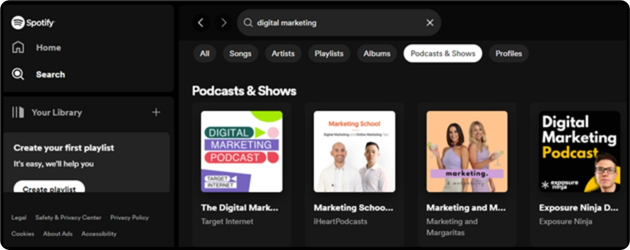
4. Micro-Influencers Make a Mark:
Forget celebrity endorsements, micro-influencers (10k-50k followers) offer higher engagement rates and authentic reach. They:
- Possess specific expertise and resonate with niche audiences.
- Foster trust and connection, making their recommendations more impactful.
- Offer better value for your outreach budget compared to big-name influencers.
The stat: Influencer marketing platform AspireIQ found that micro-influencers generate 6 times more engagement per follower than mega-influencers.
Real-world example: Eos Lip Balm partnered with micro-influencers in the beauty niche, resulting in a 400% increase in website traffic and a 20% rise in sales.
5. Voice Search Optimization:
With voice assistants like Siri and Alexa becoming increasingly popular, optimizing your outreach Search engine optimization strategy for voice search is crucial. Consider:
- Long-tail keywords: Focus on natural language phrases people use in voice searches.
- Structured data: Implement schema markup to improve voice search rankings.
- Content clarity: Create concise and informative content that answers specific questions.
The fact: Gartner predicts that 30% of all web searches will be conducted without a screen by 2020.
Real-world example: The Home Depot optimized its website for voice search, resulting in a 20% increase in voice-driven mobile conversions.
6. Content & Outreach Hand-in-Hand:
Your outreach efforts thrive when backed by high-quality content that resonates with your target audience. Integrate:
- Blog posts: Offer valuable insights and data relevant to influencers’ and their audiences’ interests.
- Infographics and visual content: Grab attention and simplify complex information for better engagement.
- Interactive tools and quizzes: Create experiences that encourage participation and generate data for future outreach.
The synergy: A study by Content Marketing Institute revealed that companies with blogs generate 55% more leads than those without.
Real-world example: Buffer, a social media management platform, created engaging infographics and secured backlinks from high-authority websites
—————————————————————————————————————————————————————–
Ennoble excelling at SEO Outreach for clients!
With 7+ years of digital marketing mastery, Ennoble Technologies crafts powerful B2B SEO strategies & B2C SEO outreach campaigns. Our team, led by a 10+year SEO veteran, delivers results that fuel your growth. Uncover the latest trends and proven SEO strategies to engage your audience and dominate the online space. Partner with Ennoble and turn website visitors into loyal customers today!
—————————————————————————————————————————————————————–
B2B Outreach: Mastering the Complex Game – Leveraging 10 Years of Expertise
B2B outreach is a different beast compared to its B2C counterpart. Longer sales cycles, complex decision-making processes, and the need for trust-building require a strategic and nuanced approach. Here, I’ll draw on my 10 years of experience to equip you with powerful B2B outreach best practices:
Understanding the Key Differences:
- Decision-Making: B2B purchases involve multiple stakeholders with diverse needs and concerns. Understand your target company’s buying journey and identify key decision-makers.
- Relationships Matter: Building genuine connections with individuals, not just titles, is crucial. Focus on providing value, not just pitching your product.
- Content is King: Offer insightful content like white papers, case studies, and industry reports that address specific pain points and showcase your expertise.
Actionable Tips for Success:
1. Research is King:
- Target the right companies: Use tools like ZoomInfo or LeadGenius to identify ideal prospects aligned with your solution.
- Know your decision-makers: Research their backgrounds, interests, and challenges to personalize your outreach.
- Understand their industry: Stay updated on industry trends and challenges to position your message for relevance.
2. Personalization is Key:
- Craft email introductions by name: Avoid generic templates and mention something specific about their work or interests.
- Offer tailored solutions: Highlight how your product/service addresses their unique needs and challenges.
- Go beyond email: Consider personalized LinkedIn messages, thought leadership pieces, or even handwritten notes for high-value targets.
3. Leverage Industry Events and Networks:
- Participate in relevant conferences and trade shows: Network with potential partners and decision-makers.
- Join industry associations and online communities: Build relationships and establish your expertise through thought leadership.
- Speak at industry events: Showcase your knowledge and gain credibility within the target audience.
4. Cultivate Relationships with Media and Influencers:
- Identify journalists and publications covering your industry: Build relationships by offering valuable insights and data.
- Contribute guest articles or industry reports: Gain exposure and establish your brand as a thought leader.
- Partner with relevant influencers: Leverage their reach and credibility to connect with key decision-makers.
5. Data & Analytics: Your Guiding Light:
- Track key metrics: Monitor open rates, click-through rates, and website traffic generated from your outreach efforts.
- Identify what’s working and what’s not: A/B test different subject lines, messaging strategies, and content formats.
- Refine your approach: Use data to continuously improve your outreach campaigns and maximize ROI.
Real-World Success Stories:
Case Study: A B2B SaaS company identified key decision-makers at target companies through LinkedIn research. By sending personalized emails with relevant case studies, they secured a 30% meeting acceptance rate.
Industry Example: A marketing agency built relationships with industry journalists by offering unique data and insights. They secured several media placements that generated qualified leads.
Remember, B2B outreach is a marathon, not a sprint. By implementing these best practices and leveraging my 10 years of experience, you can build genuine relationships, create value, and ultimately turn leads into loyal customers for your B2B business.
Cracking the B2C Code: Engaging Outreach B2C Strategies for Today’s Consumers
B2C outreach is a vibrant dance compared to its B2B counterpart. Shorter sales cycles, emotional triggers, and the need to grab attention demand a dynamic and engaging approach.
Leveraging my 10 years of experience, let’s delve into powerful B2C outreach best practices:
Understanding the Key Differences:
- Emotional Connection: Tap into emotions like excitement, joy, or fear to trigger impulsive desires and encourage action.
- Faster Conversions: B2C purchases often happen quickly, so ensure your outreach is clear, concise, and easily leads to conversion.
- Content is King, But Engagement is Queen: Go beyond informative content; create interactive experiences, user-generated content, and shareable moments.
Actionable Tips for Captivating Your Audience:
1. Master the Social Media Game:
- Engage with your audience: Respond to comments, participate in conversations, and run polls to foster a sense of community.
- Leverage influencer marketing: Partner with relevant micro-influencers who resonate with your target audience for authentic reach.
- Run contests and giveaways: Generate excitement and incentivize user interaction with appealing prizes.
2. Create Content that Sizzles:
- Focus on visuals: Utilize captivating images, videos, and infographics that grab attention and tell a story.
- Go interactive: Implement quizzes, polls, and augmented reality experiences to boost engagement.
- Optimize for mobile: Ensure your content displays flawlessly and is easily consumable on smartphones and tablets.
3. Personalization Matters, Even in the Crowd:
- Segment your audience: Create targeted campaigns based on demographics, interests, and past behavior.
- Use dynamic personalization tools: Address individuals by name and tailor messaging based on their preferences.
- Offer exclusive deals and promotions: Reward loyal customers and incentivize repeat purchases.
4. Data & Analytics: Your Performance Compass:
- Track key metrics: Monitor engagement rates, click-through rates, and conversion rates across different platforms and campaigns.
- Run A/B tests: Experiment with different headlines, images, and calls to action to see what resonates best.
- Refine your approach: Use data to continuously improve your outreach efforts and maximize ROI.
Real-World Success Stories:
Case Study: A clothing brand partnered with micro-influencers in the fashion niche. User-generated content featuring the brand led to a 20% increase in website traffic and a 15% rise in sales.
Industry Example: A food delivery app ran a social media campaign with a personalized quiz to recommend dishes. This interactive experience boosted engagement by 30% and generated valuable customer data.
Remember, B2C outreach is about creating a connection and a conversation. By implementing these best practices and leveraging my 10 years of experience, you can reach your target audience, captivate their attention, and ultimately convert them into loyal brand advocates.
Top SEO Outreach Tools:
Crafting a successful SEO outreach campaign requires the right tools to identify targets, personalize emails, and track results. Here’s a list of top options, both free and paid, categorized by their function:
| Category | Tool (Free) | Tool (Paid) |
| Target Identification | ||
| Buzzsumo | Semrush, SpyFu, Majestic, Similarweb Pro | |
| Ahrefs Backlink Checker | Buzzsumo Pro, Buzzstream | |
| Google Search Console | LinkMiner, BuzzStream Sumo | |
| Social Mention | Ahrefs Content Explorer, SE Ranking | |
| HARO | Pitchbox Guestlist, Traackr | |
| AnswerThePublic | Buzzsumo Influencers, Followerwonk | |
| Reddit Keyword Search | Pitchbox Alerts, Brand24 | |
| Quora Topic Search | Followerwonk Pro, Mention | |
| Email Personalization | ||
| Gmail Merge | Mailshake, Pitchbox, Voila Norbert | |
| Hunter | Respona, Pitchbox Email Finder | |
| MailChimp (up to 2,000 contacts) | Snov.io, ContactOut | |
| Streak for Gmail | Outreach.io, Saleshandy | |
| Boomerang for Gmail | Klout, Buzzsumo Influencers | |
| Content Creation & Tracking | ||
| Canva | Buzzsumo Sumo, Buffer, Similarweb Pro | |
| Google Analytics | Buzzsumo Pro, Pitchbox Insights | |
| Piktochart | Visme, Lumen5 | |
| Unsplash | Freepik, Storyblocks | |
| Animoto | InVideo, Wideo | |
| Google Trends | SEMrush Content Assistant, Ahrefs Content Ideas | |
| Relationship Building | ||
| LinkedIn, Twitter, HARO | Pitchbox Guestlist, Brand24, Buzzsumo Influencers | |
| Facebook Groups | Followerwonk Pro, Traackr | |
| Reddit Communities | Buzzstream, LinkMiner | |
| Quora Spaces | Ahrefs Alerts, SEMrush Brand Monitoring | |
| Discord Servers | Pitchbox Community, Buzzsumo Connect | |
| Online Events & Webinars | Traackr Discover, Buzzsumo Events | |
| Podcast Appearances | Podchaser, Matchmaker.fm |
Unlock the Power of Blogger Outreach: Turn Social Likes into Leads!
- Facebook:
Turn likes into leads! Unlock powerful B2B & B2C blogger outreach strategies & convert 70% of website visitors with free & paid tools. Get the insider tips in our blog! #SEO #leadgeneration #searchengineoptimization - Instagram:
Convert clicks to customers! Discover killer B2B & B2C blogger outreach hacks & skyrocket your lead generation with free & paid tools. Link in bio! #SEOtips #businessgrowth - LinkedIn:
Boost your sales funnel! Learn 70% conversion secrets via B2B & B2C blogger outreach & power up your lead generation with free & paid tools. Read our blog now! #B2Bmarketing #C2Cmarketing
—————————————————————————————————————————————————————–
Interesting fact – Did you know?
The average salary for an SEO outreach specialist in the United States is over $70,000 per year.
—————————————————————————————————————————————————————–
FAQs about SEO outreach specialists
Q. What skills do I need to be an SEO outreach specialist?
A. You will need strong communication and writing skills, as well as a good understanding of Search engine optimization and content marketing. You should also be able to use data analysis tools and be comfortable building relationships with people online.
Q. What is the career outlook for SEO outreach specialists?
A. The career outlook for Search engine optimization outreach specialists is very positive. The demand for SEO professionals is expected to grow in the coming years, as businesses increasingly recognize the importance of online marketing.
Q. How can I get started as an SEO outreach specialist?
A. There are a number of ways to get started as an SEO outreach specialist. You can take online courses or attend workshops to learn the skills you need. You can also start by building your own website or blog and practicing your outreach skills by trying to get backlinks from other websites.
Boost Your SEO with Influencer Outreach: The Complete Guide to Landing IoT Guest Posts
Targeting an IoT Influencer for a Guest Post Backlink: Step-by-Step Guide
Target: John Doe, Sr. Vice president of MagicCloud
Tools:
- Buzzsumo: Identify influencer’s best guest posts.
- Hunter: Find target’s email address.
- Mailshake: Personalize and send outreach emails.
Steps:
1. Research & Identify:
- Use Buzzsumo to find the influencer’s most popular guest posts on IoT topics.
- Analyze the posts for insights about their preferred content style and audience.
2. Craft a personalized pitch:
Use Hunter to find the influencer’s professional email address (avoid generic info@ emails). Draft a personalized email using Mailshake.
Here’s a sample script:
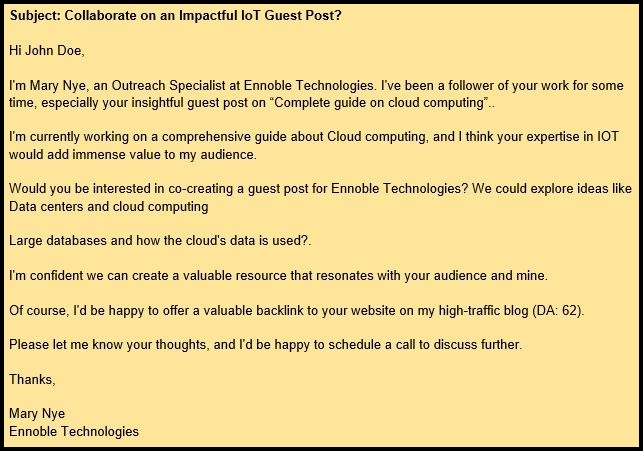
3. Personalize and Send:
- Use Mailshake’s personalization features to insert the influencer’s name, specific post title, and other relevant details.
- Send the email at an appropriate time, considering their location and time zone.
4. Follow Up:
- If you don’t receive a response within a week, send a courteous follow-up email using Mailshake.
- Be respectful of their time and avoid being pushy.
5. Negotiate & Secure Guest Post:
- If they express interest, discuss the topic, content outline, and desired backlink placement.
- Collaborate on creating a high-quality guest post that benefits both your audiences.
Remember:
- Focus on offering value and building a genuine connection.
- Respect the influencer’s time and expertise.
- Be patient and persistent, but not pushy.
- By following these steps and utilizing the recommended tools, you can increase your chances of securing a valuable backlink on an influential IoT blogger’s website.
Conclusion
In essence, the role of SEO outreach in both B2B and B2C digital marketing is rooted in enhancing online visibility, driving relevant traffic, and fostering meaningful connections with target audiences. By tailoring search engine optimization outreach strategies to the unique dynamics of B2B and B2C markets, organizations can position themselves for sustained success, drive engagement, and achieve business objectives within their respective domains. Whether engaging with businesses or individual consumers, the strategic deployment of search engine optimization outreach remains fundamental to achieving digital marketing success across diverse sectors.
Also Read: Mobile Optimization: Crucial for On-Page SEO Success – Ennoble Technologies
Also Read: On-Page SEO vs. Off-Page SEO: Which Matters More? – Ennoble Technologies
Also Read: Mastering On-Page SEO: Practical Tips & Tricks – Ennoble Technologies
Also Read: 10 On-Page SEO Mistakes You Must Avoid – Ennoble Technologies
Mobile Optimization: Crucial for On-Page SEO Success
In the fast-evolving landscape of digital marketing, staying ahead of the curve is not just a choice; it’s a necessity. As the majority of online users transition to mobile devices, the significance of mobile optimization cannot be overstated. This article delves into the intricate realm of Mobile Optimization and its pivotal role in achieving on-page SEO success.
I. Introduction
A. Definition of Mobile Optimization
Mobile Optimization refers to the process of ensuring that a website functions seamlessly and offers an optimal user experience on mobile devices. This involves responsive design, efficient loading times, and content adaptation to cater to the diverse array of mobile screens.
B. Significance of Mobile Optimization in On-Page SEO
The relationship between Mobile Optimization and on-page SEO is symbiotic. Google’s algorithms increasingly prioritize mobile-friendly websites, making it imperative for businesses and website owners to prioritize mobile optimization efforts.
C. Evolution of Mobile Usage and Its Impact on SEO
The surge in mobile device usage has transformed the digital landscape. From search behaviors to user expectations, understanding the evolution of mobile usage is crucial for devising effective mobile optimization strategies.
II. Importance of Mobile-Friendly Websites
A. User Experience (UX) and Mobile Responsiveness
1. Role of Responsive Design
Responsive design ensures that a website adapts to various screen sizes, providing a consistent and enjoyable user experience across devices. Its role in mobile optimization is foundational.
2. Impact on Bounce Rates
A mobile-friendly website contributes to lower bounce rates, indicating that users find the content engaging and accessible. High bounce rates may adversely affect search rankings.
B. Google’s Mobile-First Indexing
1. Understanding Mobile-First Index
Google’s Mobile-First Index prioritizes the mobile version of a website for indexing and ranking. Websites not optimized for mobile may experience a decline in search visibility.
2. How it Influences Search Rankings
Mobile-First Indexing directly impacts search rankings. Websites optimized for mobile devices are likely to rank higher, reflecting Google’s commitment to delivering mobile-friendly search results.
III. Key Elements of Mobile Optimization
A. Page Speed Optimization
1. Impact on Mobile Users
Mobile users are inherently impatient. Slow-loading pages can result in high bounce rates and diminished user satisfaction. Page speed optimization directly addresses these concerns.
2. Tools for Assessing and Improving Page Speed
Various tools, such as Google PageSpeed Insights, help assess and enhance page speed. These tools provide actionable insights to streamline website performance.
B. Mobile-Friendly Content
1. Crafting Engaging and Readable Content
Content tailored for mobile users prioritizes concise and engaging information. Short paragraphs, bullet points, and clear headings enhance readability on smaller screens.
2. The Role of Headings and Subheadings
Structuring content with well-defined headings and subheadings not only aids readability but also assists search engines in understanding the context of the content.
C. Mobile SEO Best Practices
1. Meta Tags and Descriptions
Optimizing meta tags and descriptions for mobile devices ensures that search results display relevant and concise information, encouraging users to click through.
2. Structured Data Markup for Mobile
Implementing structured data markup helps search engines comprehend the content’s structure, leading to enhanced visibility and rich snippets in mobile search results.

IV. Responsive Design vs. Mobile Apps
A. Advantages and Disadvantages of Responsive Design
1. Flexibility and Consistency
Responsive design offers flexibility by adapting to different devices, maintaining consistency in branding and user experience. However, potential drawbacks need careful consideration.
2. Mobile Apps and SEO
While mobile apps provide a dedicated user experience, optimizing them for search engines presents challenges. Balancing the advantages and disadvantages is crucial for mobile SEO success.
B. Mobile Apps and SEO
1. Enhanced User Experience
Mobile apps can deliver a tailored and immersive user experience. Capitalizing on app-specific features contributes to increased user engagement.
2. Challenges in App-Optimized SEO
Optimizing mobile apps for search engines requires unique strategies. Overcoming challenges related to app indexing and content visibility is paramount.
V. Technical Aspects of Mobile Optimization
A. Mobile Crawlability
1. Ensuring Accessibility for Search Engines
Search engines must efficiently crawl and index mobile content. Ensuring mobile crawlability involves eliminating obstacles that hinder search engine access.
2. Common Mobile Crawl Issues
Identifying and resolving common mobile crawl issues, such as blocked resources or faulty redirects, is essential for maintaining a robust mobile presence in search results.
B. Mobile Sitemaps
1. Importance in Indexing
A well-structured mobile sitemap aids search engines in understanding the website’s mobile content, facilitating efficient indexing and retrieval.
2. Creating an Effective Mobile Sitemap
Crafting a mobile sitemap involves delineating the structure of mobile pages, URLs, and their interrelationships. This ensures comprehensive coverage in search engine indexes.
VI. Optimizing Images and Multimedia for Mobile
A. Importance of Compressed Images
1. Impact on Loading Speed
Large image files can significantly slow down page loading times. Compressing images without compromising quality is pivotal for mobile optimization.
2. Tools for Image Compression
Utilizing image compression tools, such as TinyPNG or ImageOptim, assists in reducing file sizes while maintaining visual integrity.
B. Video Optimization for Mobile
1. Embedding Mobile-Friendly Videos
Mobile optimization extends to multimedia. Embedding videos optimized for mobile devices enhances user engagement and page performance.
2. Improving Video Loading Times
Optimizing video loading times, possibly through adaptive streaming and efficient encoding, contributes to a seamless mobile user experience.

VII. User Engagement Metrics for Mobile
A. Dwell Time and Its Significance
1. Measuring User Engagement
Dwell time, the duration a user spends on a page, is a critical metric. Longer dwell times indicate user satisfaction and relevance, positively impacting SEO.
2. Strategies for Increasing Dwell Time
Compelling content, intuitive navigation, and relevant internal links are strategies to increase dwell time, signaling to search engines the value of the content.
B. Mobile-Friendly Call-to-Actions
1. Designing Actionable CTAs
Mobile-friendly call-to-actions should be visually appealing and easy to interact with on smaller screens. They play a pivotal role in driving desired user actions.
2. Impact on Conversion Rates
Efficiently designed mobile CTAs contribute to improved conversion rates, translating user engagement into desired outcomes, such as sign-ups or purchases.
VIII. Mobile SEO Analytics
A. Utilizing Mobile Analytics Tools
1. Google Analytics for Mobile
Google Analytics provides insights into mobile user behavior, allowing webmasters to track performance, identify trends, and make data-driven decisions.
2. Interpreting Mobile-Specific Metrics
Metrics like mobile bounce rates, device-specific traffic, and conversion rates offer valuable insights into the effectiveness of mobile optimization strategies.
B. A/B Testing for Mobile Optimization
1. Experimenting with Mobile Variations
A/B testing involves experimenting with different elements on mobile pages to identify optimal configurations. This iterative process fine-tunes mobile optimization strategies.
2. Analyzing Test Results
Thorough analysis of A/B test results informs ongoing optimization efforts, ensuring that changes positively impact user experience and SEO performance.
IX. Challenges and Solutions in Mobile Optimization
A. Device Fragmentation
1. Addressing Compatibility Issues
The diverse landscape of mobile devices poses challenges in ensuring compatibility. Strategies like responsive design and testing on various devices are crucial.
2. Progressive Enhancement vs. Graceful Degradation
Choosing between progressive enhancement and graceful degradation strategies depends on the target audience and balancing advanced features with broad compatibility.
B. Future-Proofing Mobile SEO
1. Adapting to Technological Changes
Staying ahead involves anticipating and adapting to technological shifts, such as changes in mobile devices, screen sizes, and user behaviors.
2. Staying Ahead of Mobile Algorithm Updates
Regularly monitoring and adapting to mobile algorithm updates, including Google’s, ensures that a website remains optimized and visible in search results.
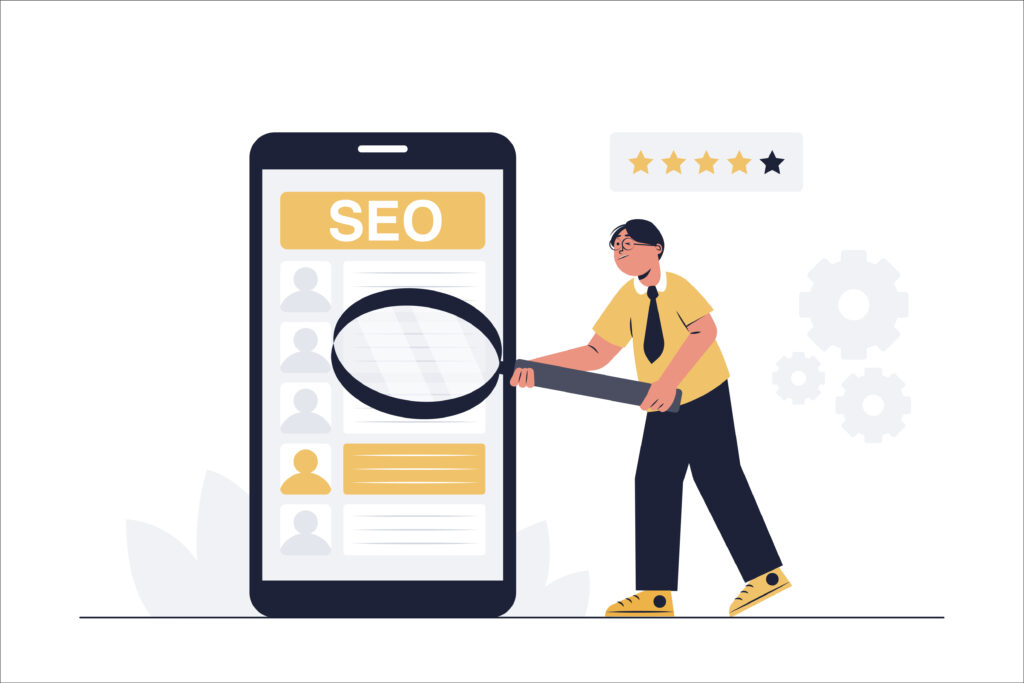
X. Case Studies on Successful Mobile Optimization
A. Examining Noteworthy Examples
1. Before and After Mobile Optimization
Analyzing case studies showcasing websites before and after mobile optimization highlights the tangible impact on organic traffic and user engagement.
2. Impact on Organic Traffic and Conversions
Successful mobile optimization correlates with increased organic traffic, improved search rankings, and a positive impact on conversion rates.
XI. Mobile Optimization and Local SEO
A. The Intersection of Mobile and Local Searches
1. Local SEO Strategies for Mobile
Tailoring mobile optimization efforts to local SEO considerations enhances visibility in location-based searches, a critical aspect for businesses with a physical presence.
2. Importance of Mobile Maps and Location-Based Information
Integrating mobile maps and providing accurate location-based information ensures that businesses are easily discoverable in mobile search results.
XII. Mobile Security Concerns and SEO
A. Ensuring Secure Mobile Transactions
SSL Certificates and Mobile SEO
- Highlighting the role of SSL certificates in securing mobile transactions and its positive impact on SEO.
Building Trust through Mobile Security
- Discussing the importance of establishing trust with users through robust mobile security measures.
XIII. Voice Search and Mobile Optimization
A. The Rise of Voice Searches
Optimizing for Voice-Based Queries
- Exploring strategies to optimize content for voice search, considering the increasing prevalence of voice-activated devices.
Impact on Mobile SEO Strategies
- Discussing how voice search trends influence the evolution of mobile SEO strategies.
XIV. Mobile Optimization for E-Commerce Websites
A. Unique Challenges in Mobile E-Commerce
Mobile Shopping Experience
- Addressing challenges specific to mobile shopping experiences and providing solutions for enhanced user engagement.
Mobile Checkout Optimization
- Offering tips for optimizing the mobile checkout process to reduce friction and increase conversions.
XV. Social Media Integration and Mobile SEO
A. Mobile-Friendly Social Sharing
Importance for SEO
- Emphasizing the impact of mobile-friendly social sharing on SEO and social media visibility.
Integrating Social Media Buttons Responsively
- Providing guidelines for seamlessly integrating social media buttons into mobile interfaces.

XVI. The Role of Mobile-Friendly AMP Pages
A. Accelerated Mobile Pages (AMP)
Benefits for SEO
- Explaining the advantages of AMP in terms of improved page speed and its positive influence on SEO rankings.
Implementing AMP for Improved Page Speed
- Offering practical insights into implementing AMP for enhanced mobile page loading speed.
XVII. International SEO and Mobile Optimization
A. Mobile SEO for Multilingual Websites
Hreflang Tags and Mobile Versions
- Explaining the use of hreflang tags to optimize mobile versions of multilingual websites for international SEO.
Addressing International Mobile SEO Challenges
- Discussing common challenges in international mobile SEO and providing solutions.
XVIII. Mobile SEO Checklist
A. Comprehensive Checklist for Mobile Optimization
Technical Checks
- Listing essential technical checks to ensure a well-optimized mobile website.
Content and Design Checks
- Highlighting key elements to review regarding mobile content and design.
XIX. Keeping Abreast of Mobile SEO Trends
A. Continuous Learning and Adaptation
Staying Informed about Industry Changes
- Recommending resources and strategies for staying updated on evolving mobile SEO trends.
Attending Mobile SEO Conferences and Webinars
- Encouraging professionals to participate in events for networking and learning from industry experts.
XX. Conclusion
A. Recap of Key Mobile Optimization Takeaways
Summarizing the key points discussed throughout the blog post, emphasizing their significance in achieving successful mobile optimization.
B. Emphasizing the Ongoing Importance of Mobile SEO
Concluding with a reminder of the perpetual importance of mobile optimization in the ever-changing landscape of online search and user behavior.
Also Read: On-Page SEO vs. Off-Page SEO: Which Matters More? – Ennoble Technologies
On-Page SEO vs. Off-Page SEO: Which Matters More?
SEO, a crucial aspect of online visibility, comes in various forms. In the realm of Search Engine Optimization, the debate often centers around On-Page SEO and Off-Page SEO. In this comprehensive guide, we delve into the nuances of both strategies, exploring their strengths, and weaknesses, and ultimately answering the question: Which Matters More?
Introduction
SEO is the backbone of digital success, and understanding its intricacies is paramount for any online venture. The landscape is dominated by two main approaches: On-Page SEO and Off-Page SEO. Each plays a distinct role in enhancing a website’s visibility on search engines, but the question persists – which one holds more weight?
Unveiling the Power of On-Page SEO
Crafting Content that Commands Attention
On-Page SEO is the bedrock of a well-optimized website. At its core, it revolves around optimizing individual web pages to rank higher and earn organic traffic. The linchpin of On-Page SEO is undoubtedly content.
When we talk about content optimization, it’s not just about integrating keywords seamlessly but creating a symphony of words that captivates and informs. High-quality, relevant, and engaging content not only satisfies search engine algorithms but also keeps your audience hooked.
The Alchemy of Keywords
In the world of On-Page SEO, keywords reign supreme. Thorough keyword research is the secret sauce that propels your content to the top of search engine results. From long-tail keywords to semantic search, understanding the nuances of what your audience is searching for is key to unlocking the full potential of On-Page SEO.
Strategically placing keywords in titles, meta descriptions, and throughout the content enhances the discoverability of your page, signaling to search engines that your content is not just relevant but authoritative.
Technical Excellence: The Backbone of On-Page Optimization
Beyond captivating content and strategic keyword placement, the technical aspects of your website cannot be overlooked. From meta tags and image alt attributes to mobile responsiveness and site speed, every technical facet contributes to the holistic optimization of your web pages.
Ensuring a seamless user experience and a technically sound website not only pleases search engines but also enhances user satisfaction, a factor increasingly crucial in the ever-evolving landscape of SEO.
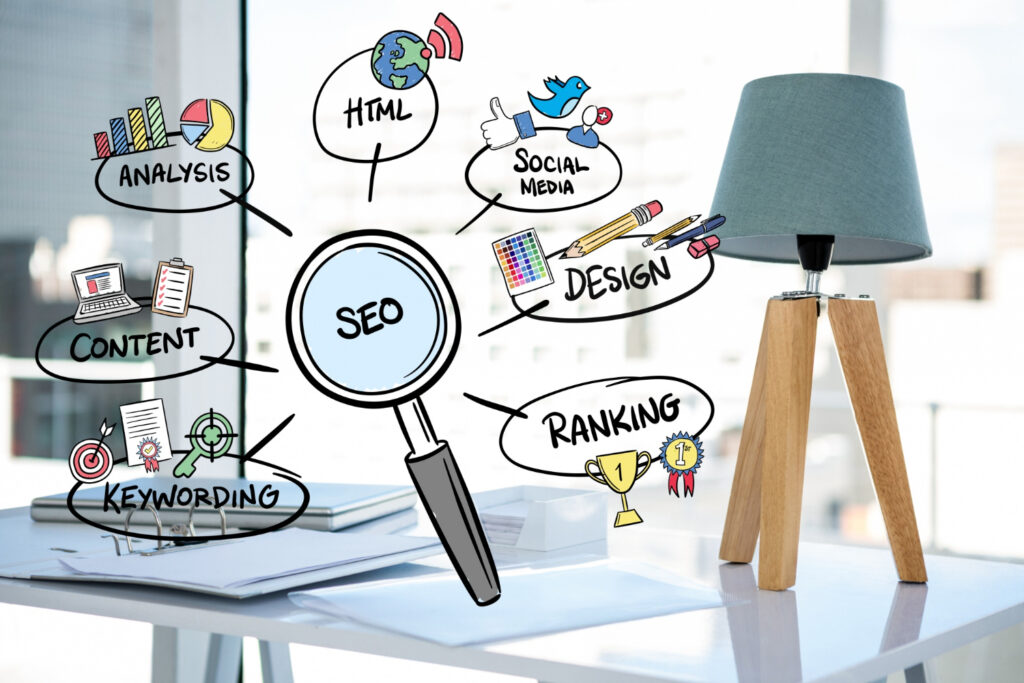
Importance of On-Page SEO
The significance of On-Page SEO cannot be overstated. It is the first impression your website makes on search engines, influencing ranking and user engagement. Dive deep into this section to uncover why On-Page SEO is the cornerstone of a robust online presence.
Key On-Page SEO Elements
Explore the key elements that constitute effective On-Page SEO. From meta descriptions to header tags, understanding and implementing these elements is crucial for optimizing your web pages for search engines.
Advanced On-Page Strategies
Beyond the basics, there are advanced strategies that can propel your On-Page SEO efforts to new heights. Uncover these techniques and stay ahead in the competitive digital landscape.
Decoding the Impact of Off-Page SEO
Backlinks: Building Bridges to Authority
Off-Page SEO, on the other hand, extends its influence beyond the boundaries of your website. It is the art of building a digital reputation through external factors, with backlinks taking center stage.
Acquiring high-quality backlinks from authoritative sources is akin to building bridges to your website. Each link acts as a vote of confidence, signaling to search engines that your content is deemed valuable by others in the digital ecosystem. The more credible the source, the more significant the impact on your website’s authority.
Social Signals: A Symphony of Validation
In the age of social media dominance, social signals have emerged as influential players in Off-Page SEO. The buzz, shares, and mentions across various social platforms contribute to the validation of your content’s relevance and appeal.
Crafting shareable content and actively participating in social conversations not only amplifies your brand presence but also sends positive signals to search engines about the societal value of your content.
Off-Page SEO Defined
Contrary to On-Page SEO, Off-Page SEO involves external factors that influence your website’s ranking. This section breaks down the components of Off-Page SEO and its role in the grand scheme of things.
Building Backlinks
Backlinks are the currency of Off-Page SEO. Learn how to build high-quality backlinks that not only improve your website’s authority but also contribute to higher search engine rankings.

Social Signals and Off-Page SEO
In an era dominated by social media, understanding how social signals impact Off-Page SEO is crucial. Discover the synergy between your social media presence and search engine rankings.
Content Marketing in Off-Page SEO
Content remains king, even in the realm of Off-Page SEO. Explore how creating valuable content can attract external links, elevating your website’s authority in the digital space.
Comparing On-Page and Off-Page Strategies
A side-by-side analysis is essential to determine the strengths and weaknesses of On-Page and Off-Page SEO. This section provides a comprehensive comparison to help you make informed decisions.
The Synergy of On-Page and Off-Page SEO
While the debate often revolves around choosing one over the other, the true power lies in their synergy. Discover how combining On-Page and Off-Page SEO strategies can create a holistic and effective approach to online visibility.
Common Misconceptions
In the ever-evolving world of SEO, myths and misconceptions abound. Separate fact from fiction as we debunk common myths surrounding both On-Page and Off-Page SEO strategies.
SEO Case Studies
Real-world examples speak volumes. Explore case studies highlighting successful On-Page and Off-Page SEO strategies, providing insights into what works in different scenarios.
Future Trends in SEO
The digital landscape is dynamic, and SEO is no exception. Gain a glimpse into the future as we predict upcoming trends and innovations that will shape the SEO landscape.
Conclusion
In the tug-of-war between On-Page and Off-Page SEO, the answer to which matters more lies in their harmonious integration. Both are indispensable, and a balanced approach ensures sustainable online success. As you navigate the intricate world of SEO, Navigating the dynamic landscape of SEO requires a holistic understanding of On-Page and Off-Page strategies. As you embark on your SEO journey, remember, it’s not about choosing one over the other; it’s about embracing the power of both.
FAQs
Q: Is On-Page SEO more important than Off-Page SEO?
A: On-Page and Off-Page SEO are symbiotic. While On-Page SEO lays the foundation, Off-Page SEO builds the structure. Both are essential for holistic search engine optimization.
Q: How do backlinks affect Off-Page SEO?
A: Backlinks act as a vote of confidence for your website. Quality backlinks enhance your site’s authority and positively impact Off-Page SEO, contributing to higher search engine rankings.
Q: Can social media really influence Off-Page SEO?
A: Absolutely. Social signals, such as likes and shares, indicate content relevance. A robust social media presence correlates with improved Off-Page SEO, driving organic traffic.
Q: What role does content play in Off-Page SEO?
A: Content is the linchpin. Creating valuable, shareable content attracts external links, a fundamental aspect of Off-Page SEO. Quality content contributes significantly to online visibility.
Q: Are there SEO strategies that combine On-Page and Off-Page techniques?
A: Certainly. The most effective SEO strategies embrace both On-Page and Off-Page techniques. The synergy between these approaches amplifies the overall impact on search engine rankings.
Q: Are SEO myths affecting my digital strategy?
A: It’s common to encounter myths. However, staying informed through credible sources and ongoing learning is crucial to separating fact from fiction in the ever-evolving field of SEO.
Also Read: Mastering On-Page SEO: Practical Tips & Tricks – Ennoble Technologies
Mastering On-Page SEO: Practical Tips & Tricks
Mastering on-page SEO (Search Engine Optimization) is crucial for improving your website’s visibility and ranking on search engines. Here are practical tips and tricks to help you optimize your on-page elements effectively:
Mastering On-Page SEO – Practical Tips & Tricks
Keyword Research:
- Begin by researching relevant keywords for your content using tools like Google Keyword Planner or SEMrush.
- Focus on long-tail keywords that are specific to your content and have moderate search volume.
Title Tags:
- Craft compelling and concise title tags (around 60 characters) that include your primary keyword.
- Ensure the title is relevant to the content and encourages clicks.
Meta Descriptions:
- Write engaging meta descriptions (around 155-160 characters) that summarize the content and include a call-to-action.
- Although meta descriptions don’t directly impact rankings, they influence click-through rates.
URL Structure:
- Create clean and SEO-friendly URLs that include relevant keywords.
- Avoid using generic URL structures with random strings of numbers or characters.

Header Tags:
- Use header tags (H1, H2, H3, etc.) to structure your content logically.
- Include your main keyword in the H1 tag and use H2, H3 tags for subheadings.
Keyword Placement:
- Naturally incorporate your target keywords in the first paragraph and throughout the content.
- Avoid keyword stuffing, as it can harm your SEO efforts.
Image Optimization:
- Optimize image file names and use descriptive alt text to make images search engine-friendly.
- Compress images to ensure faster page loading times.
Content Quality:
- Create high-quality, relevant, and valuable content that addresses user intent.
- Longer content often performs well, but focus on providing value rather than just length.
Internal Linking:
- Add internal links to relevant pages within your website to improve navigation and distribute link equity.
- Use descriptive anchor text that includes keywords.
User Experience (UX):
- Ensure a positive user experience by optimizing page load speed and mobile responsiveness.
- Use clear and concise formatting with bullet points, headings, and easy-to-read text.
Schema Markup:
- Implement schema markup to provide search engines with additional information about your content.
- This can enhance your search results with rich snippets.

Social Media Integration:
- Integrate social sharing buttons to encourage users to share your content.
- Social signals can indirectly impact search rankings.
Regular Content Updates:
- Keep your content up-to-date to show search engines that your site is active and relevant.
- Refresh old content and add new information when necessary.
Page Speed Optimization:
- Compress images, leverage browser caching, and use content delivery networks (CDNs) to improve page load speed.
- Google considers page speed as a ranking factor.
Analytics and Monitoring:
- Use tools like Google Analytics and Google Search Console to monitor your website’s performance.
- Analyze user behavior, track keywords, and make data-driven adjustments.
By implementing these on-page SEO tips and tricks, you’ll enhance your website’s visibility, provide a better user experience, and ultimately improve your search engine rankings. Regularly monitor and adjust your strategy based on performance data and industry trends.
The Foundation: Choosing the Right Keywords
Selecting the right keywords is the cornerstone of effective on-page SEO. Conduct thorough research to identify phrases aligned with your content. Tools like Google Keyword Planner can assist in uncovering high-ranking keywords that resonate with your target audience.
Crafting Captivating Titles: A Magnetic Force
Your page title is the first impression on both users and search engines. Craft compelling titles that not only include your primary keyword but also entice readers. A captivating title sets the stage for increased click-through rates.
Headers That Speak Volumes
Utilize headers strategically by incorporating relevant keywords. H1 tags should encapsulate the main topic, while subsequent headers (H2, H3, etc.) can delve into subtopics. This hierarchy not only aids SEO but also enhances the readability of your content.
Meta Descriptions: Your 155-Character Elevator Pitch
Craft concise and engaging meta descriptions that encapsulate the essence of your content within 155 characters. Include primary keywords naturally to entice users to click through. Think of it as your digital elevator pitch – short, impactful, and enticing.
URL Optimization: Simplify for Success
Optimize your URLs by keeping them concise and reflective of your content. Include relevant keywords, separate words with hyphens, and avoid unnecessary characters. A clean and straightforward URL contributes to both user experience and search engine visibility.

Image Alt Text: The Silent SEO Contributor
Don’t overlook the power of image alt text. Describe your images using relevant keywords to enhance accessibility and provide search engines with additional context. Alt text is a subtle yet effective way to boost your on-page SEO efforts.
Content is King: Quality Over Quantity
Ensure your content is not only informative but also engaging. Create in-depth, valuable content that addresses user queries. Google favors content that satisfies user intent, so focus on quality over quantity to secure a prominent place in search results.
User-Friendly Experience: Mobile Optimization
With the majority of users accessing the internet via mobile devices, optimizing your website for mobile is non-negotiable. Ensure responsive design, fast loading times, and a seamless mobile experience to enhance both user satisfaction and SEO performance.
Internal Linking: The Web of Connectivity
Integrate internal links strategically to connect relevant pages within your website. This not only aids in navigation but also distributes link authority, boosting the SEO value of your content. Foster a web of connectivity that keeps users exploring your site.
Analytics: Your SEO Compass
Regularly monitor your website’s performance through analytics tools. Track user behavior, page views, and bounce rates. Analyzing this data provides insights into what is working and allows for adjustments to optimize your on-page SEO strategy continuously.
Conclusion:
In conclusion, mastering on-page SEO requires a strategic approach encompassing keyword research, compelling titles, headers, meta descriptions, URL optimization, image alt text, quality content, mobile optimization, internal linking, and diligent analytics. Implement these practical tips and tricks to unlock the full potential of your website in the competitive digital landscape.
Also Read: 10 On-Page SEO Mistakes You Must Avoid – Ennoble Technologies
10 On-Page SEO Mistakes You Must Avoid
Understanding Crucial On-Page SEO Mistakes
As digital landscapes evolve, mastering on-page SEO practices becomes pivotal. Amidst the quest for visibility and higher rankings, steering clear of certain blunders is paramount. Let’s delve into ten critical on-page SEO mistakes that can significantly impact your website’s performance and discover effective strategies to sidestep these pitfalls.
1. Neglecting Title Tags: The Gateway to Visibility
Title Tags: Your virtual welcome mat to users and search engines alike. Overlooking their significance undermines visibility. Ensure title tags encapsulate relevant keywords, succinctly describe content, and entice clicks.
2. Subpar Content Quality: The Foundation of Engagement
Content Quality: The cornerstone of user engagement and SEO success. Lackluster, uninformative, or duplicated content repels users and downgrades your site’s ranking potential. Focus on original, valuable, and keyword-rich content to captivate audiences and appease search algorithms.
3. Ignoring Meta Descriptions: A Missed Opportunity
Meta Descriptions: Often underestimated, these snippets play a vital role in attracting clicks. Crafting compelling, concise meta descriptions infused with keywords and a clear call-to-action can significantly enhance click-through rates.
4. Unoptimized URL Structures: Navigational Clarity Matters
URL Structures: An often overlooked but pivotal aspect of on-page SEO. Clean, descriptive, and keyword-rich URLs aid both search engines and users in understanding your content. Avoid lengthy, convoluted URLs that hinder navigation and comprehension.
5. Inadequate Internal Linking: Overlooking Pathways
Internal Links: The navigational arteries within your site. Neglecting a well-structured internal linking system inhibits user exploration and hampers search engine crawlers’ ability to index and comprehend your content thoroughly. Thoughtful internal linking bolsters both user experience and SEO.
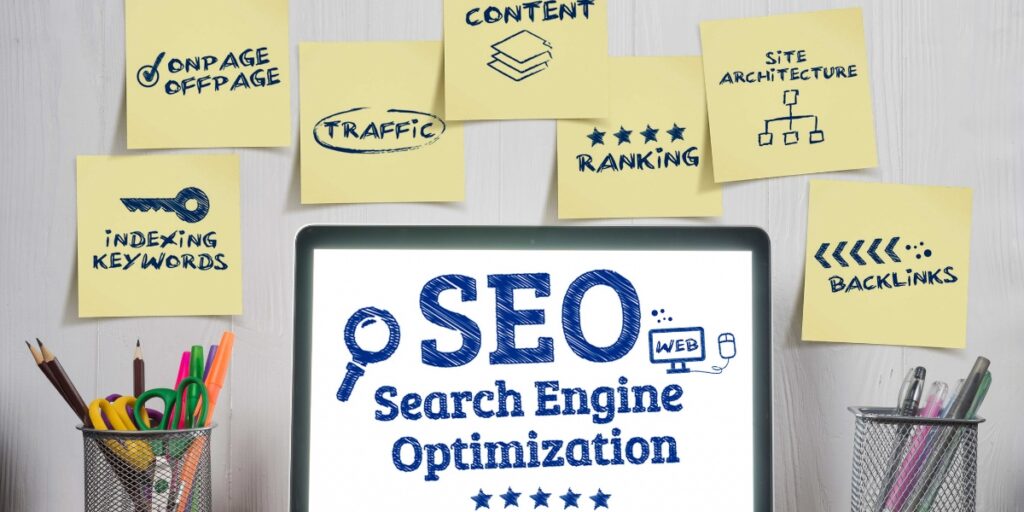
6. Mobile Unfriendliness: Alienating a Vast Audience
Mobile Optimization: An indispensable aspect in today’s mobile-centric world. Failing to optimize for mobile alienates a significant user base and adversely affects rankings. Responsive design and mobile-friendly interfaces are imperative for SEO success.
7. Slow Page Loading: The Impatience Factor
Page Loading Speed: Users patience dwindles with sluggish loading times. A slow-loading site frustrates visitors, impacting bounce rates and search engine rankings. Optimize images, leverage caching, and streamline code to ensure swift page loading.
8. Neglecting Image Optimization: A Blind Spot
Image Optimization: Often overlooked, yet a treasure trove of SEO potential. Images add value but can also slow down sites if improperly optimized. Utilize descriptive filenames, employ alt tags with relevant keywords, and compress images for improved performance.
9. Excessive Focus on Keyword Stuffing: Balancing Act
Keyword Stuffing: Once deemed advantageous, now a perilous practice. Overloading content with keywords disrupts readability, irritates users, and triggers search engine penalties. Strive for a natural keyword integration that enhances context and readability.
10. Disregarding Analytics: The Power of Insight
Analytical Neglect: Failure to track and analyze website performance inhibits progress. Leverage analytics to discern user behavior, identify bottlenecks, and fine-tune your SEO strategies for continual improvement.
Navigating the On-Page SEO Terrain
Avoiding these ten on-page SEO blunders is pivotal for an effective digital presence. By meticulously optimizing title tags, content quality, URLs, internal linking, and mobile responsiveness while prioritizing page speed, image optimization, and prudent keyword usage, one can navigate the SEO landscape adeptly. Coupling these efforts with analytical insights ensures a robust, evolving SEO strategy primed for success.
Implementing Effective SEO Measures: A Continuous Journey
The realm of on-page SEO is a dynamic landscape, demanding ongoing vigilance and adaptation. Consistently updating strategies, staying abreast of industry trends, and refining approaches based on analytics foster a resilient digital presence.
Expanding Your SEO Arsenal: Tools and Resources
1. SEO Auditing Tools
Leverage comprehensive SEO auditing tools such as Screaming Frog, Ahrefs, or SEOptimer to conduct in-depth site analyses, identifying areas for enhancement and gauging your SEO health.
2. Structured Data Markup
Employ structured data markup, like Schema.org, to provide search engines with context, enrich search results, and potentially secure coveted rich snippets for improved visibility.
3. Semantic Keyword Research
Shift focus from mere keyword density to semantic keyword research. Understanding user intent and incorporating semantically related terms diversifies content, enhancing relevance without resorting to keyword stuffing.

Strategies for Unparalleled On-Page SEO Success
1. E-A-T Principle Implementation
Adopt Google’s E-A-T principle (Expertise, Authoritativeness, Trustworthiness) to fortify content. Credible, well-researched, and authoritatively crafted content aligns with Google’s quality standards.
2. Rich Snippet Optimization
Strive for rich snippet optimization by structuring content in a way that caters to featured snippets. Concise answers to queries, lists, tables, and clear formatting improve visibility in search results.
3. Voice Search Optimization
With the proliferation of voice search, optimize content for natural language queries. Tailor content to address conversational search queries, leveraging long-tail keywords and providing succinct, informative responses.
Conclusion: Sustaining SEO Excellence
Embracing on-page SEO practices demands vigilance, adaptability, and an unwavering commitment to user-centric, value-driven content. Evolve alongside search engine algorithms, integrate diverse strategies, and prioritize user experience to maintain a resilient digital footprint.
FAQs: Addressing Common Queries
Q. How often should I update my website’s content for optimal SEO performance?
A. The frequency of content updates depends on various factors. Aim for consistent updates to keep content relevant and fresh, aligning with your industry’s dynamics and audience needs.
Q. Are there any specific tools to aid in on-page SEO optimization?
A. Yes, several tools like SEMrush, Moz, and Google’s own Search Console offer valuable insights and functionalities for on-page SEO optimization.
Q. Can excessive internal linking negatively impact SEO?
A. Yes, excessive internal linking without context or relevance can confuse users and signal spammy practices to search engines. Focus on natural, relevant internal linking for optimal results.
Q. Can guest blogging positively impact on-page SEO?
A. Yes, when executed judiciously. Guest blogging on reputable sites within your niche can amplify brand visibility, drive traffic, and secure valuable backlinks if the content is high-quality and relevant.
Q. How can I rectify on-page SEO mistakes if they’ve already impacted my site?
A. Start by conducting a comprehensive audit to identify specific issues. Address each mistake methodically, focusing on improving content quality, optimizing technical aspects, and adhering to best SEO practices.
Q. Are meta keywords still relevant for on-page SEO?
A. No, meta keywords hold negligible value for modern search engines. Focus on crafting compelling meta titles, descriptions, and user-focused content, rather than meta keywords.
Also Read: Unlocking the Potential: Paid Advertising Strategies for Maximum Impact – Ennoble Technologies
Top 5 E-Commerce SEO Services to Catapult Your Online Store to Stardom
Introduction
In the bustling digital marketplace, elevating your online store’s visibility is crucial. E-Commerce SEO services play an indispensable role in optimizing your online presence, driving organic traffic, and boosting sales. Here are the top 5 e-commerce SEO services that can skyrocket your online store to new heights.
1. Keyword Research and Optimization
In the realm of SEO, keywords are paramount. Keyword research and optimization service help identify the most relevant and high-ranking keywords for your e-commerce store. Integrating these keywords into your product descriptions, meta tags, and URLs increases the likelihood of your store ranking high on search engine result pages (SERPs), thus attracting a larger audience.
Benefits:
- Improved online visibility
- Enhanced organic traffic
- Higher search engine rankings
2. On-Page SEO Services
On-page SEO focuses on optimizing individual pages of your website. This service ensures that content is high-quality, relevant, and keyword-rich. It also involves optimizing title tags, headings, and images, enhancing the overall user experience and making your site more appealing to search engines.
Benefits:
- Increased page relevance
- Better user experience
- Improved page loading speed
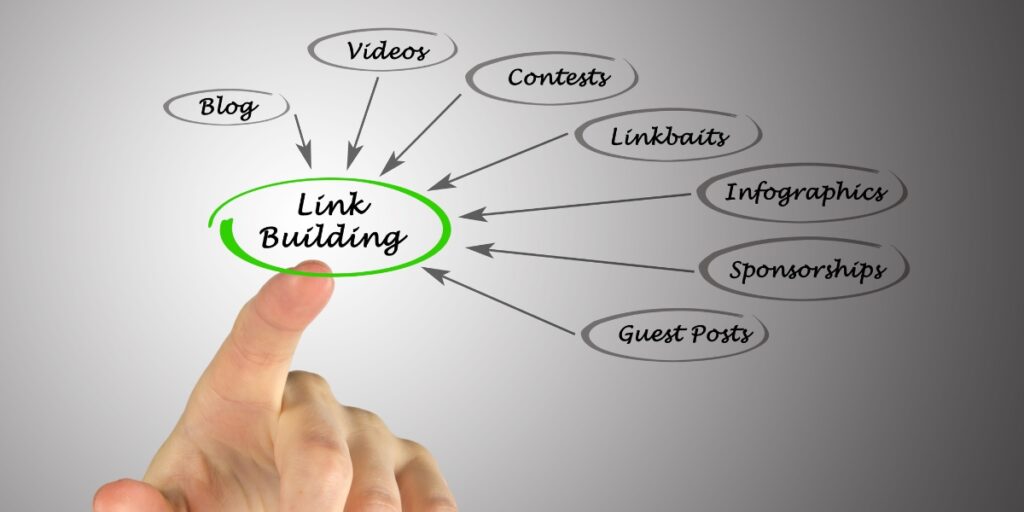
3. Link-Building Services
Quality backlinks are a significant ranking factor for search engines. Link-building services concentrate on acquiring these valuable links from reputable sites, pointing back to your online store. This increases your store’s authority and trustworthiness, signaling to search engines that your site is a credible source of information.
Benefits:
- Enhanced domain authority
- Improved credibility and trustworthiness
- Higher search engine rankings
4. Technical SEO Services
The backbone of an effective SEO strategy is robust technical SEO. This service focuses on optimizing the backend structure of your site, improving site speed, mobile optimization, and eliminating crawl errors, ensuring search engines can efficiently index and rank your site.
Benefits:
- Enhanced site usability
- Improved site speed and performance
- Better mobile optimization
5. Content Marketing Services
Content is king in the digital world. Content marketing services help in creating and promoting valuable, relevant, and consistent content aimed at attracting and retaining a clearly-defined audience. Quality content helps in establishing brand authority, driving engagement, and improving conversion rates.
Benefits:
- Increased brand awareness and authority
- Improved customer engagement and loyalty
- Higher conversion rates
E-Commerce SEO Strategies: Unlocking the Gates to Online Visibility and Traffic
In the digital era, where online stores are burgeoning, competition is intense. E-commerce SEO strategies play a pivotal role in making your store visible to a broader audience. It’s not just about stuffing keywords; it’s about understanding your audience, the search engine algorithms, and amalgamating knowledge to drive organic traffic, ensuring your online store stands out amongst the myriad available.

1. Comprehensive SEO Audit and Analysis
A meticulous E-commerce SEO audit and analysis is crucial for identifying weaknesses and opportunities in your online store. It helps in refining SEO strategies, fixing technical issues, and improving site performance, all of which are vital for boosting your online store’s visibility.
2. Prudent Keyword Research
Conducting insightful keyword research for online stores is foundational. It involves identifying high-volume, low-competition keywords relevant to your products and audience, helping you optimize content and attract the right customers to your online shop.
3. Enhancing On-Page SEO
Effective on-page SEO for e-commerce encompasses optimizing meta titles, descriptions, header tags, and URLs. Utilizing primary, secondary, and long-tail keywords in these elements can significantly enhance your store’s search engine ranking and visibility.
4. Off-Page SEO: Building Authority
Implementing strategic off-page SEO for e-commerce involves creating high-quality backlinks and promoting your online store on social media and other platforms. It’s crucial in establishing your site’s authority and improving its position in search engine results.
5. Optimizing Product Pages
Optimizing product pages for SEO is about crafting compelling, keyword-rich content, optimizing images, and implementing structured data. These actions are critical in making product pages more searchable and appealing to potential customers.

6. E-Commerce Content Optimization
Quality, relevance, and keyword richness are paramount in e-commerce content optimization. Creating engaging, informative, and SEO-friendly content like blog posts and product descriptions can enhance user experience and increase organic traffic.
7. Effective Link Building Strategies
For link building for online shops, securing high-quality, relevant backlinks is critical. It involves outreach, guest posting, and leveraging social media, contributing significantly to your e-commerce site’s domain authority and search engine ranking.
8. Mobile-Friendly SEO Approach
Mobile-friendly e-commerce SEO is non-negotiable in today’s mobile-centric world. Responsive design, fast loading times, and seamless navigation are essential components in providing optimal mobile user experience and ranking higher in mobile search.
9. Advanced Technical SEO
Robust technical SEO for e-commerce platforms is indispensable. It covers site speed optimization, clean and efficient coding, and efficient crawlability and indexation, which are crucial for improving search visibility and user experience.
10. Structuring E-Commerce Site Architecture
Effective e-commerce site architecture and SEO go hand in hand. A well-structured, intuitive, and SEO-friendly site architecture aids in enhancing user experience, reducing bounce rate, and improving the overall search engine ranking of your online store.
11. Conversion Rate Optimization
Conversion rate optimization for online stores is about refining the user journey from entering the site to making a purchase. A/B testing, user feedback, and analytics assessment are pivotal in optimizing conversion paths and turning visitors into customers.
Conclusion: Crafting a Successful E-Commerce SEO Strategy
In conclusion, sculpting an effective SEO strategy is indispensable for e-commerce success. It requires a multifaceted approach involving comprehensive SEO audit and analysis, prudent keyword research, on-page and off-page optimization, link building, mobile-friendly SEO approaches, technical SEO, structured e-commerce site architecture, and diligent conversion rate optimization. By implementing these e-commerce SEO strategies, not only can online stores enhance their visibility and traffic, but they can also create a more user-friendly and engaging experience for their customers, ultimately outshining competitors and achieving sustained online success.
Drive Growth E-commerce with Online Advertising: A Comprehensive Guide
Introduction
In today’s digital age, the world of e-commerce offers immense potential for businesses to expand their reach and boost revenue. One of the most powerful tools at your disposal is online advertising. By strategically leveraging online advertising, you can drive growth in your e-commerce venture like never before. This comprehensive guide will walk you through the ins and outs of utilizing online advertising to supercharge your e-commerce growth.
Drive Growth E-commerce with Online Advertising

Online advertising has transformed the way businesses connect with their target audiences. It allows you to reach potential customers across various online platforms, creating brand awareness, driving traffic, and ultimately boosting sales. By aligning your advertising efforts with your business goals, you can achieve remarkable results.
The Power of Online Advertising in E-commerce

In a highly competitive e-commerce landscape, online advertising offers a competitive edge. It enables you to tap into the vast online user base and showcase your products or services to the right people at the right time. This targeted approach significantly increases your chances of conversion and growth. We delve into the myriad ways you can leverage online advertising to drive e-commerce growth.
1. Understanding Target Demographics
To create a successful online advertising campaign, we first need to have a deep understanding of our target demographics. Recognizing their preferences, buying habits, and online behaviors provides invaluable insights. Armed with this information, we can tailor our advertisements to resonate more deeply, increasing the likelihood of conversion.
2. Embracing Multiple Advertising Platforms
While many e-commerce businesses might be tempted to stick with tried and true platforms like Google AdWords, we advise diversifying advertising efforts. Platforms like Facebook, Instagram, Pinterest, and even TikTok offer unique opportunities to reach different segments of your target audience. By embracing multiple platforms, we can cast a wider net and pull in a more varied customer base.
3. Prioritizing Mobile-First Advertising
With a significant chunk of online shopping happening on mobile devices, we must prioritize mobile-first advertising strategies. This involves optimizing ads for mobile screens, ensuring speedy page load times, and simplifying the checkout process for mobile users.
4. Leveraging Retargeting Strategies
Ever wondered why a product you viewed on a website seems to follow you around on other platforms? That’s retargeting in action. By using retargeting strategies, we can remind potential customers of products they’ve shown interest in, nudging them closer to a purchase.
5. Utilizing Video Content
Video content is not just for entertainment. We’ve seen a marked increase in conversion rates for e-commerce businesses that employ video ads. Demonstrating product use, showing it in action, or illustrating its benefits through video can be much more effective than static images.
6. Integrating Seamless Checkout Processes
Once a potential customer clicks on our ad, half the battle is won. But to convert this interest into a sale, we need to ensure that our checkout processes are as seamless as possible. Streamlined, easy-to-navigate, and secure checkouts boost consumer confidence and increase conversion rates.
7. Analyzing and Adapting
The digital landscape is always changing. What works today might not necessarily work tomorrow. As such, we need to be in a constant state of analysis and adaptation. By monitoring our online advertising campaigns closely, we can quickly pivot and adjust our strategies based on real-time data.
8. Creating Value Propositions
While it might be tempting to rely solely on discounts or sales to drive traffic, we believe in the power of value propositions. Offering unique selling points, exclusive content, or value-added services can make our e-commerce platform stand out in a sea of competitors.
9. Ensuring Transparency and Authenticity
In an age where consumers are more discerning than ever, transparency and authenticity go a long way. By being open about our business practices, showcasing real reviews, and interacting genuinely with customers, we can build trust. And trust, in the realm of e-commerce, translates to loyalty and repeat business.
Types of Online Advertising for E-commerce

1. Search Engine Advertising: Utilize platforms like Google Ads to display your products or services prominently when users search for relevant keywords. This ensures your offerings are visible to potential customers actively looking for what you offer.
2. Social Media Advertising: Leverage the massive user bases of platforms like Facebook, Instagram, and Twitter to showcase your products through engaging visual content. Precise audience targeting options allow you to reach users based on demographics, interests, and behaviors.
3. Display Advertising: Display ads on websites and apps that your target audience frequents. These ads come in various formats, from banners to videos, grabbing users’ attention and directing them to your e-commerce site.
4. Influencer Collaborations: Partner with influencers in your industry to promote your products. Their authentic endorsements can build trust among their followers and drive traffic to your ecommerce store.
Crafting Compelling Ad Campaigns
Creating effective online ad campaigns requires a blend of creativity, strategy, and data analysis.
Utilizing LSI Keywords for Ad Copy
Incorporate Latent Semantic Indexing (LSI) keywords into your ad copy. LSI keywords are contextually related terms that enhance your ad’s relevance, making it more likely to appear in relevant searches.
Engaging Visuals and Copywriting
Captivating visuals paired with persuasive copy can make your ads stand out. Highlight the unique value propositions of your products, addressing pain points and offering solutions.
A/B Testing for Optimization
Regularly conduct A/B tests on different ad elements such as headlines, images, and calls-to-action. This data-driven approach helps you identify the most effective components and refine your campaigns for better results.
Enhancing User Experience on Your E-commerce Site
A successful ad campaign is only part of the equation. Ensuring a seamless user experience on your e-commerce website is crucial for converting ad clicks into sales.
Mobile-Friendly Design
Optimize your website for mobile devices to accommodate the growing number of mobile users. A responsive design ensures a smooth experience regardless of the device used.
Clear Navigation and Product Information
Simplify site navigation and provide comprehensive product information. Users should easily find what they’re looking for and make informed purchase decisions.
Leveraging Data Analytics for Continuous Improvement
Data-driven decision-making is key to refining your online advertising strategies and achieving sustained growth.
Monitoring Key Metrics
Regularly monitor metrics such as click-through rates, conversion rates, and return on ad spend. These insights help you identify which campaigns are performing well and where adjustments are needed.
Retargeting and Remarketing
Implement retargeting campaigns to re-engage users who visited your site but didn’t complete a purchase. Remarketing ads can remind them of their interest and nudge them towards conversion.
Scaling Successful Campaigns
Identify campaigns that consistently deliver positive results and consider scaling them. Increasing your investment in high-performing campaigns can lead to exponential growth.
FAQs about Driving E-commerce Growth through Online Advertising

Q: How quickly can I expect to see results from my online advertising efforts?
A: Results can vary depending on factors like your industry, budget, and campaign strategy. However, with effective targeting and optimization, you can start seeing noticeable improvements within a few weeks.
Q: What’s the ideal budget for an e-commerce online advertising campaign?
A: There’s no one-size-fits-all answer. Your budget should align with your goals and the competitiveness of your industry. Start with a manageable budget and increase it as you see positive returns.
Q: How can I ensure my ads resonate with my target audience?
A: Conduct thorough audience research to understand their preferences, pain points, and behaviors. Craft ad content that speaks directly to their needs and aspirations.
Q: Are there any pitfalls to avoid in e-commerce online advertising?
A: Avoid overselling and using misleading clickbait. Transparency and authenticity build trust with your audience and lead to sustainable growth.
Q: Can I handle online advertising on my own, or should I hire a professional?
A: While managing your own campaigns is possible, enlisting the help of professionals can save you time and potentially yield better results. Their expertise can help you navigate the intricacies of online advertising.
Q: What’s the role of storytelling in online advertising for e-commerce?
A: Storytelling humanizes your brand and creates an emotional connection with your audience. Sharing stories about your products, brand journey, or satisfied customers can set you apart from competitors.
Conclusion
Online advertising has become a cornerstone of e-commerce growth. By understanding the various strategies, optimizing your campaigns, and delivering exceptional user experiences, you can harness its power to drive remarkable growth in your e-commerce venture. Stay adaptive, keep learning, and watch your business flourish in the digital landscape.
Also Read: Prevent E-commerce Fraud with Our Tips: A Comprehensive Guide – Ennoble Technologies

